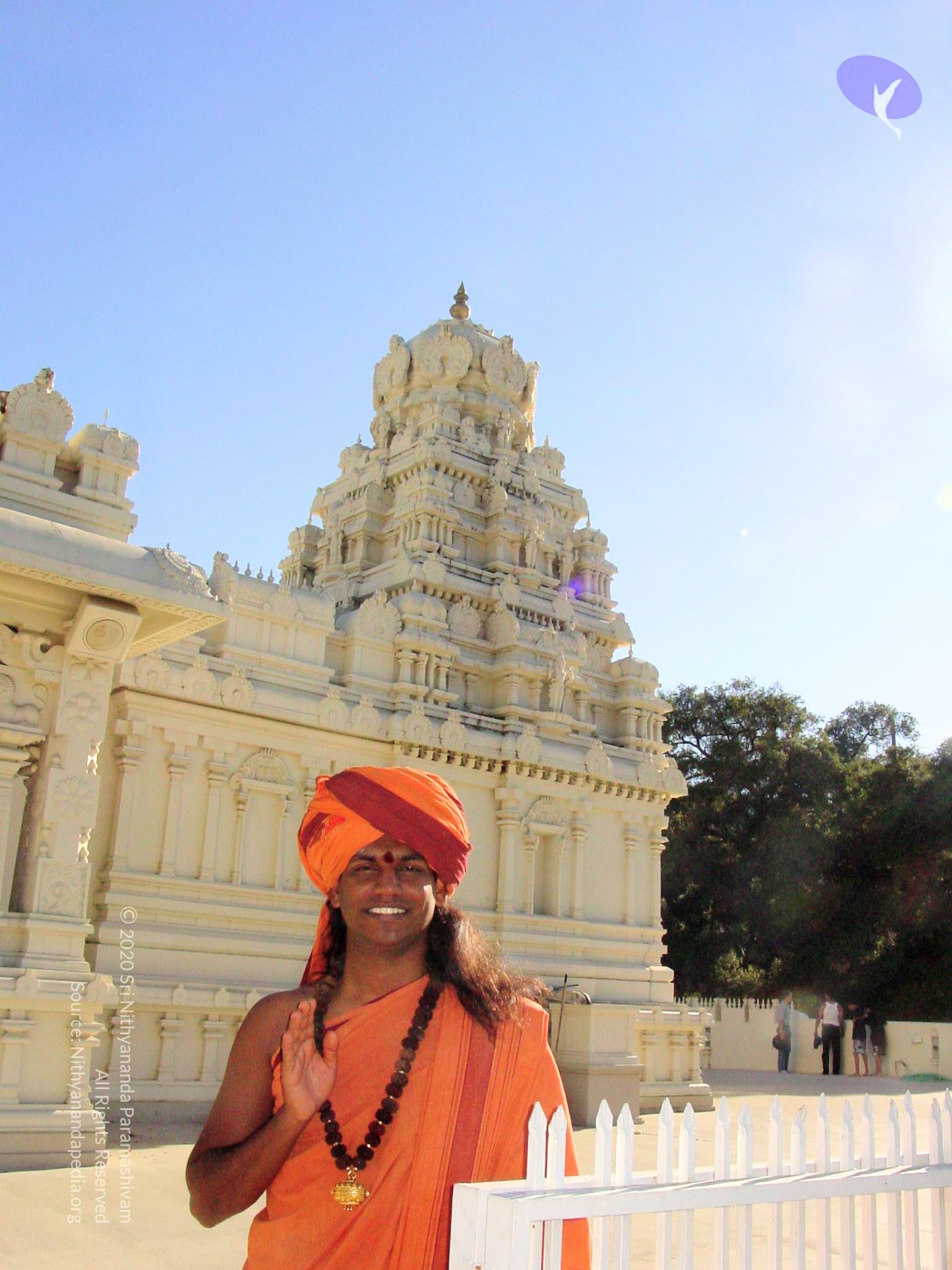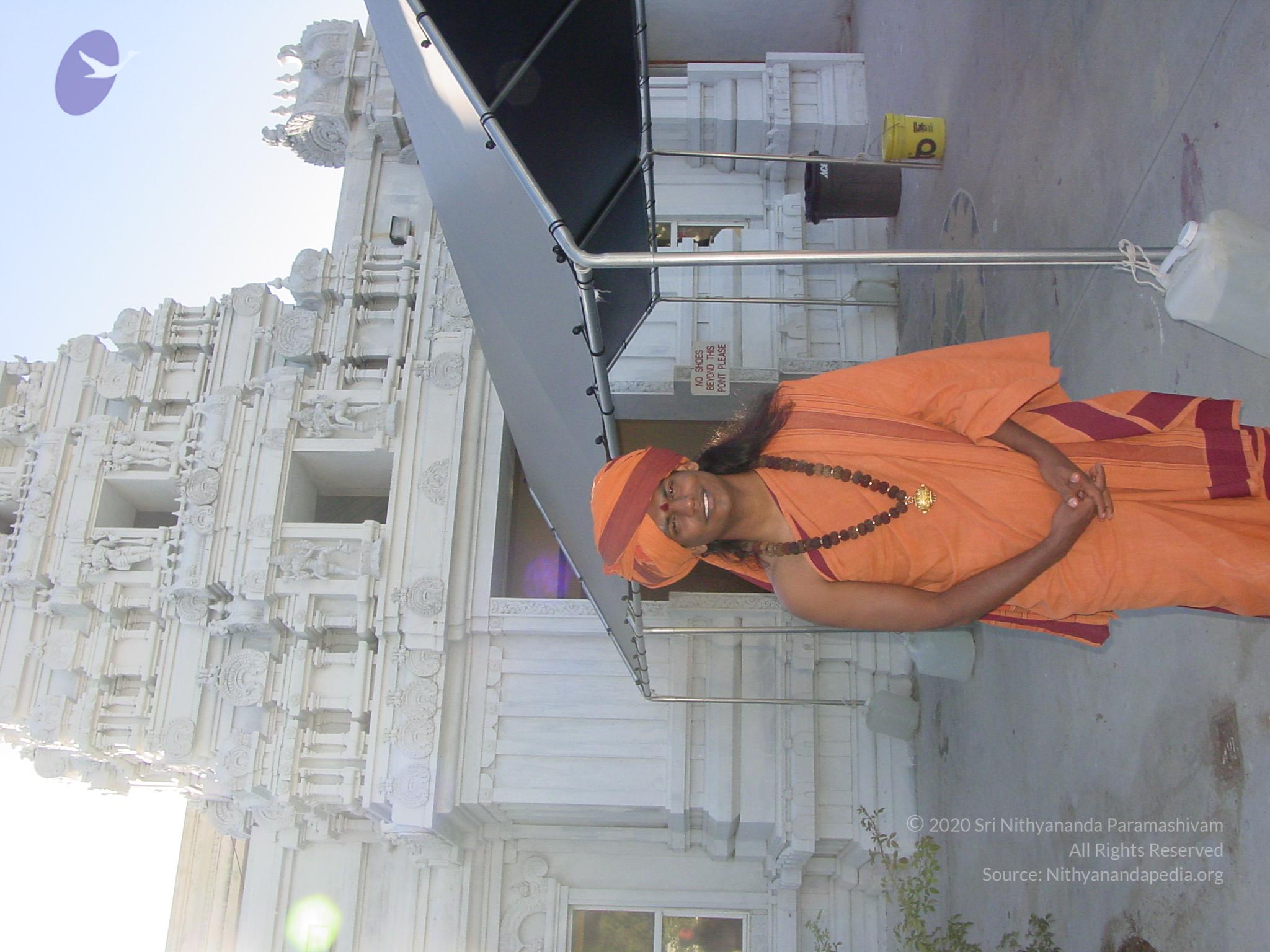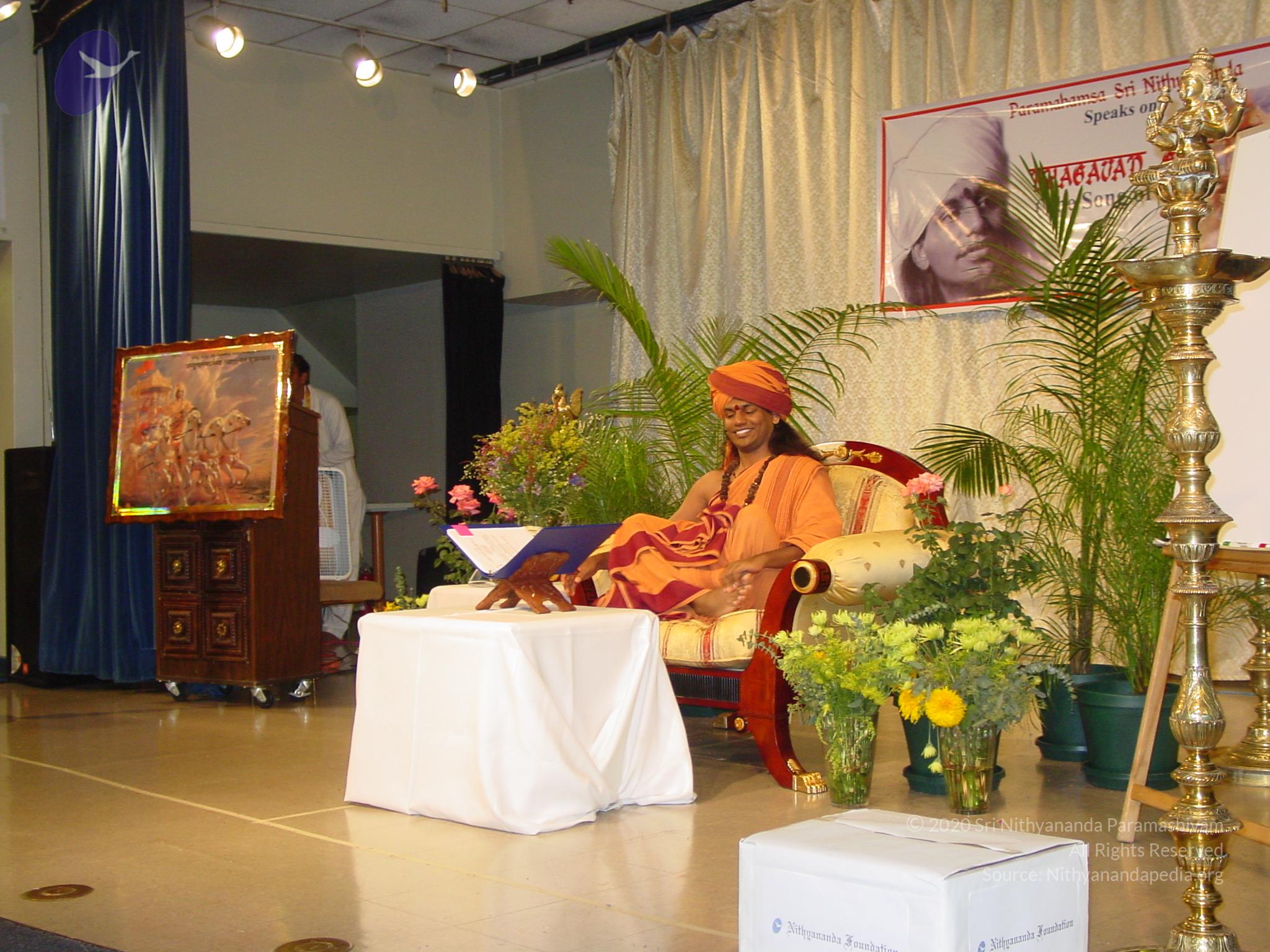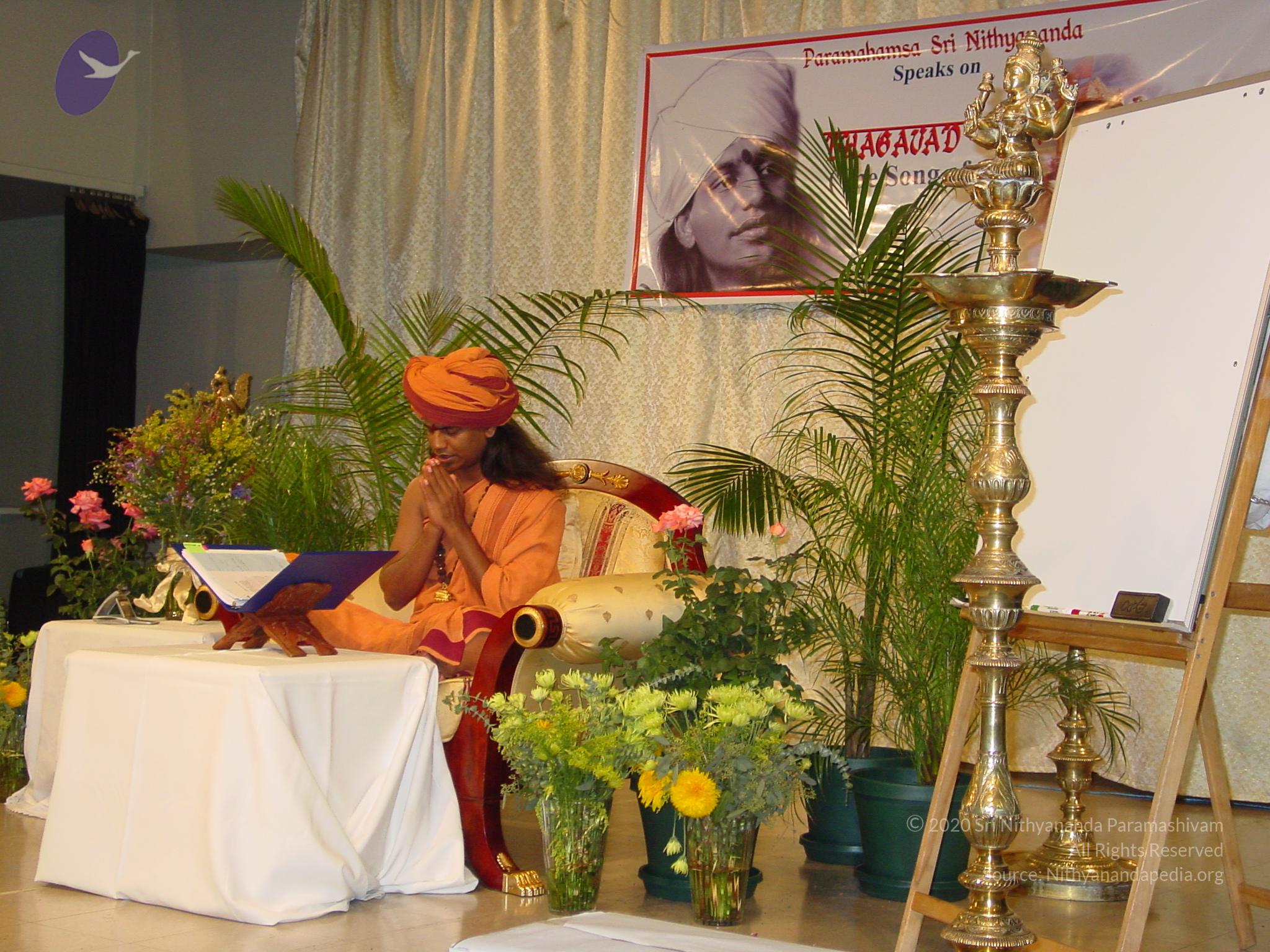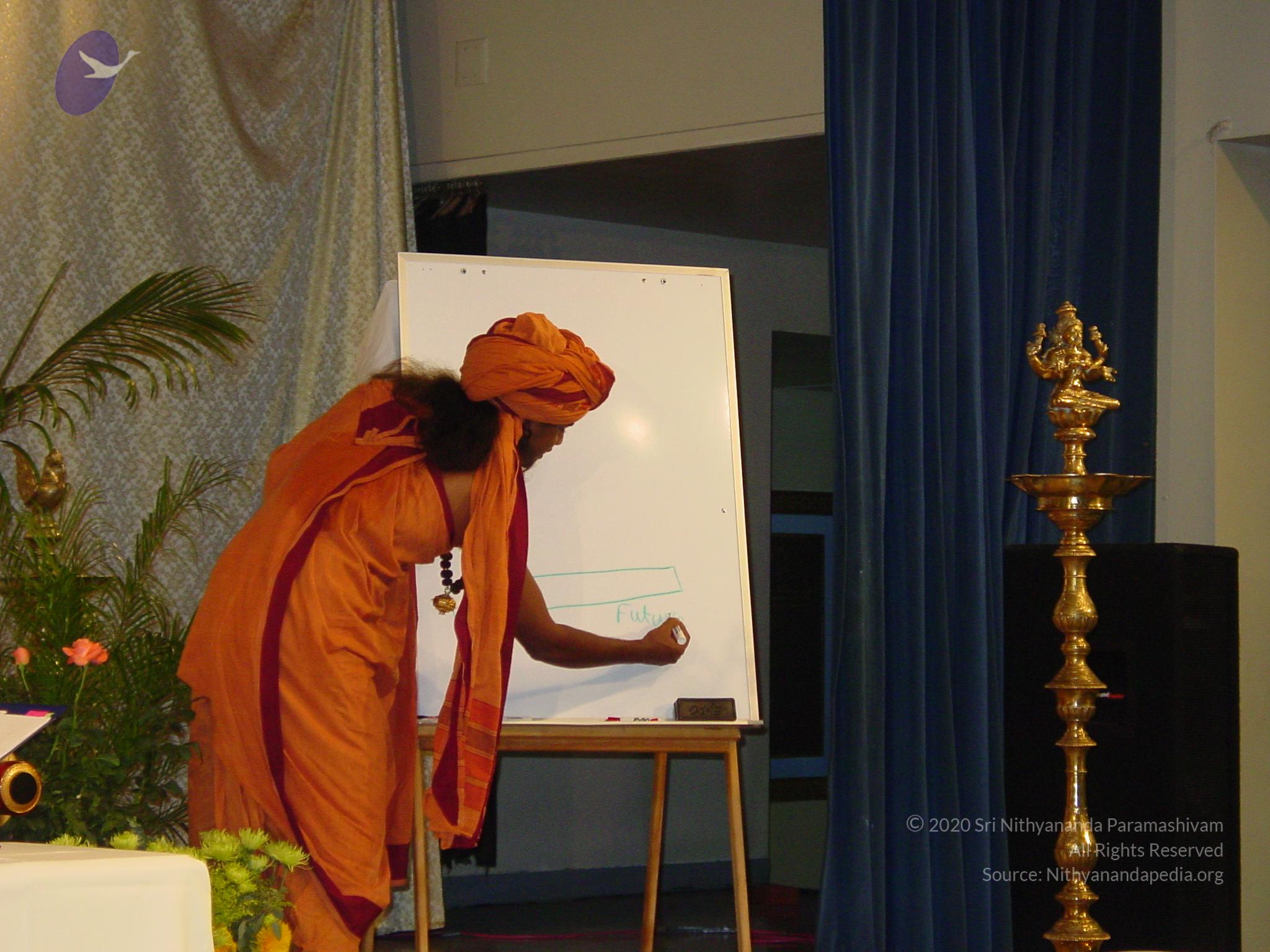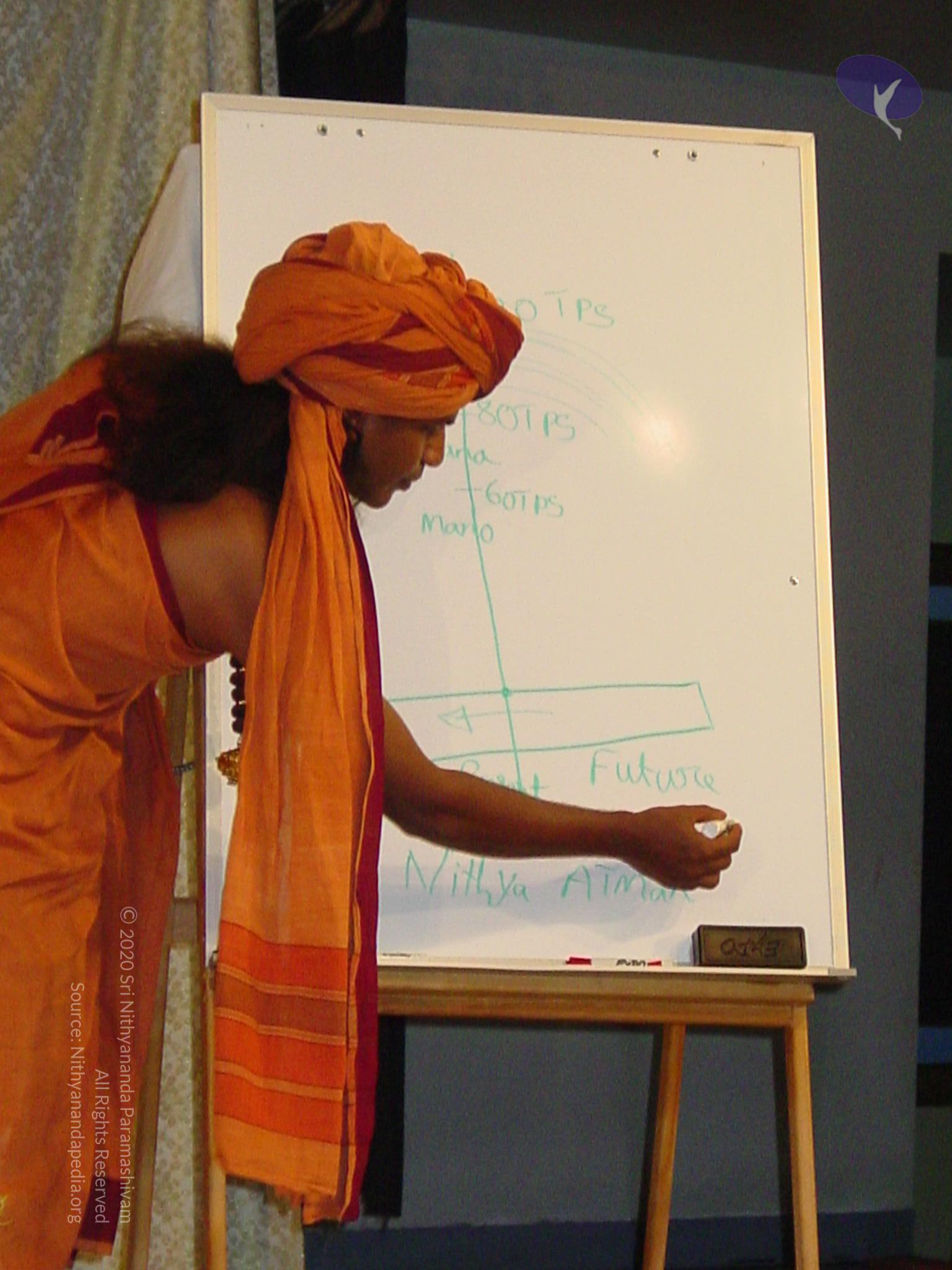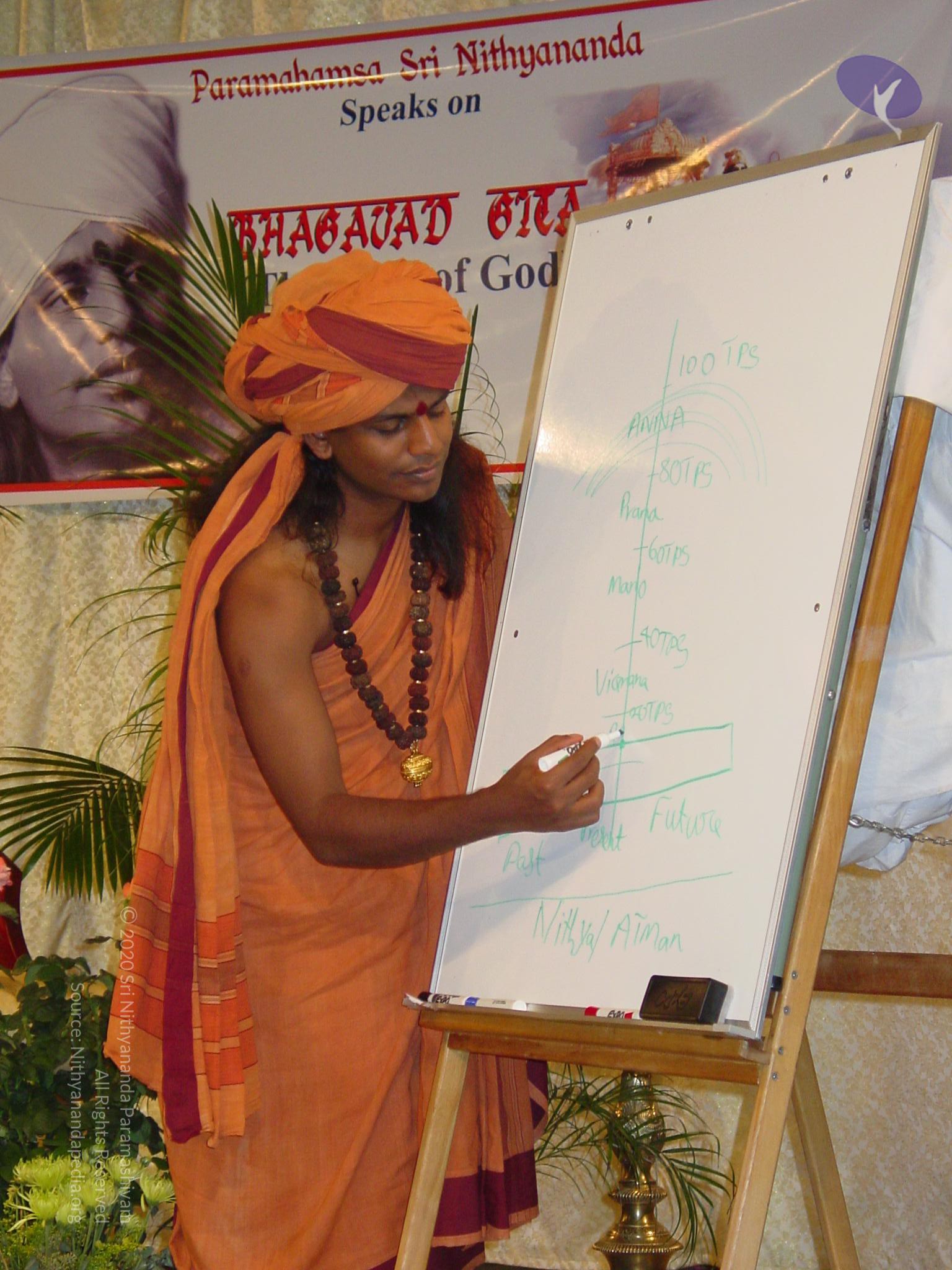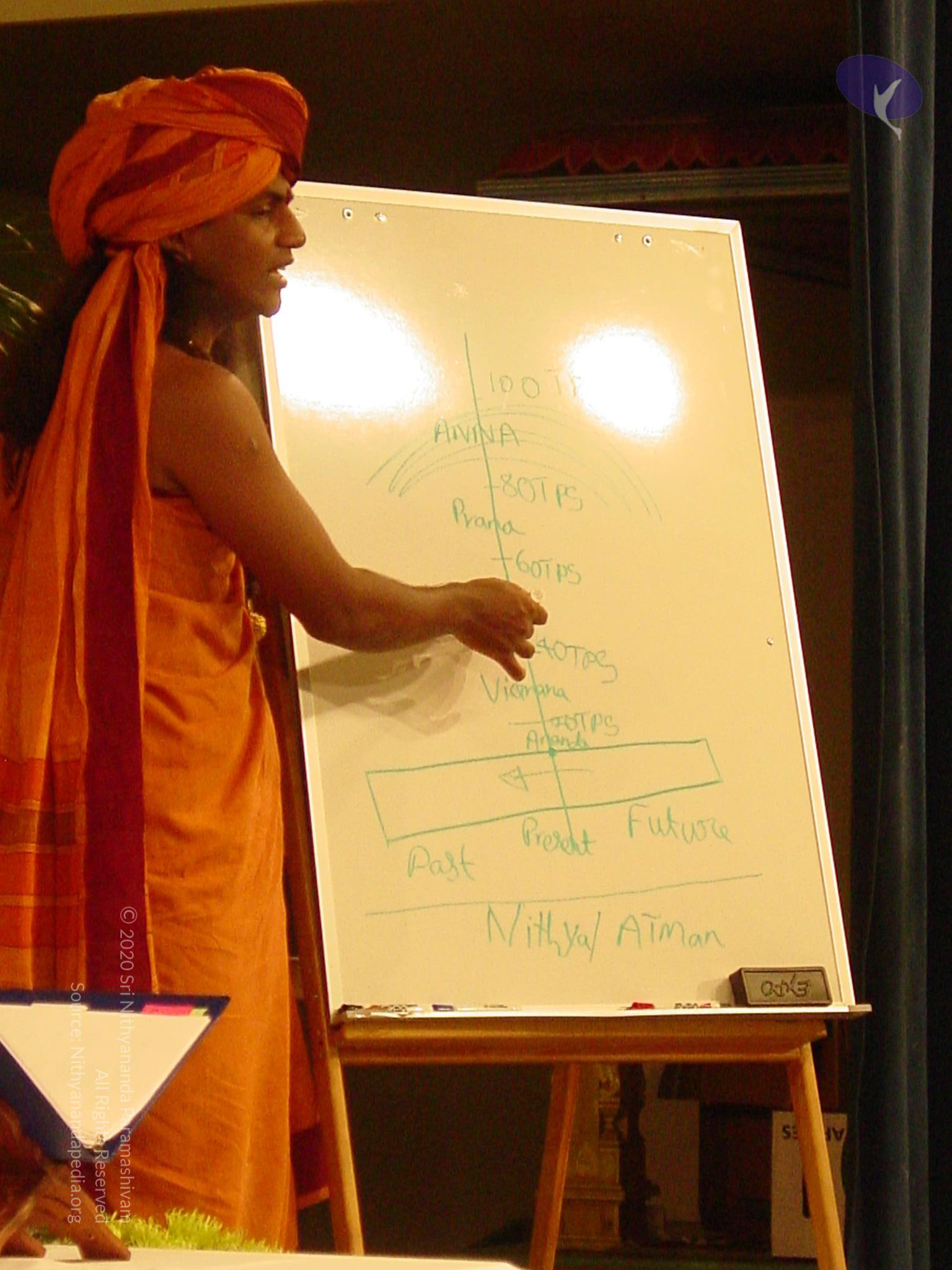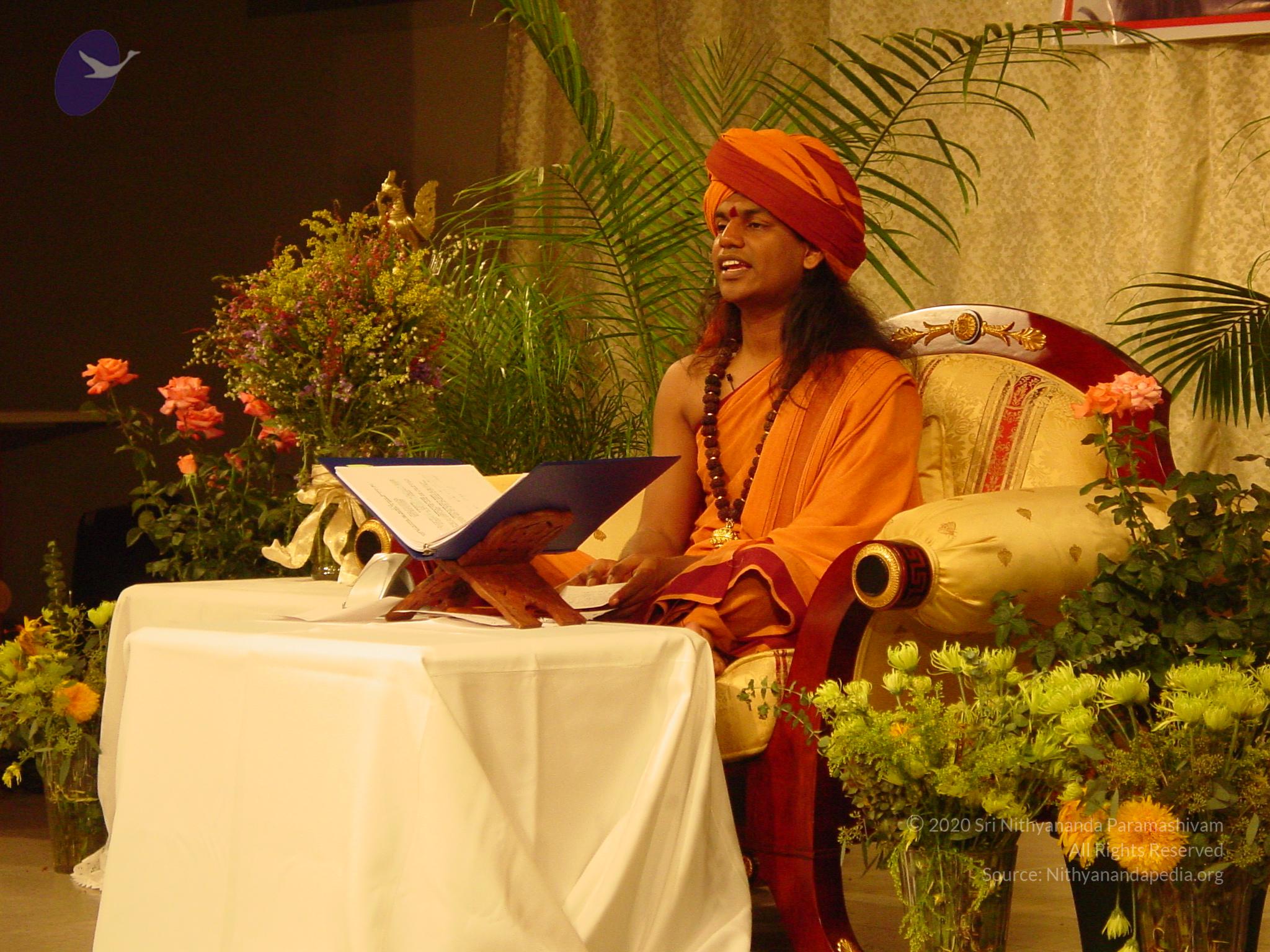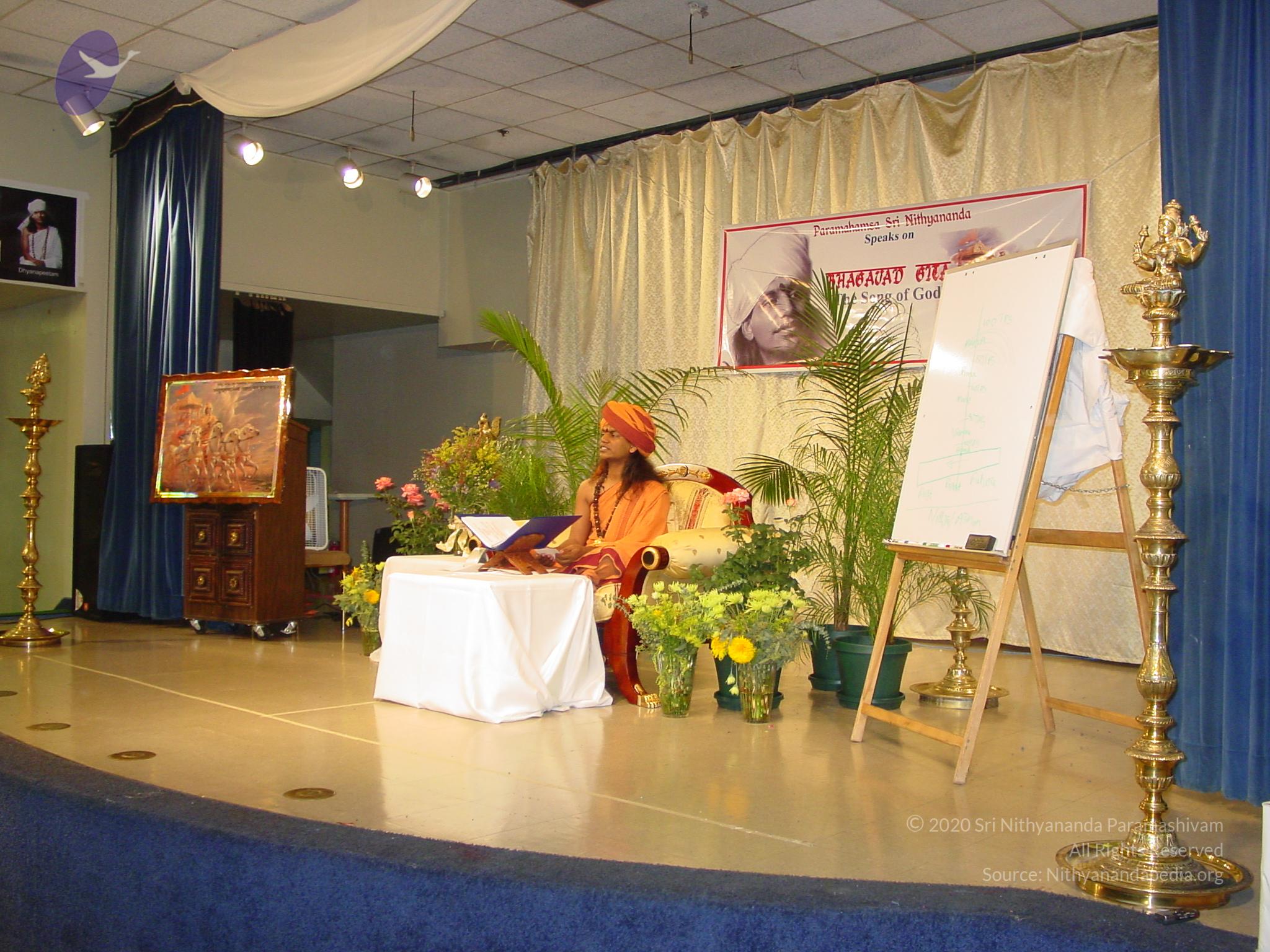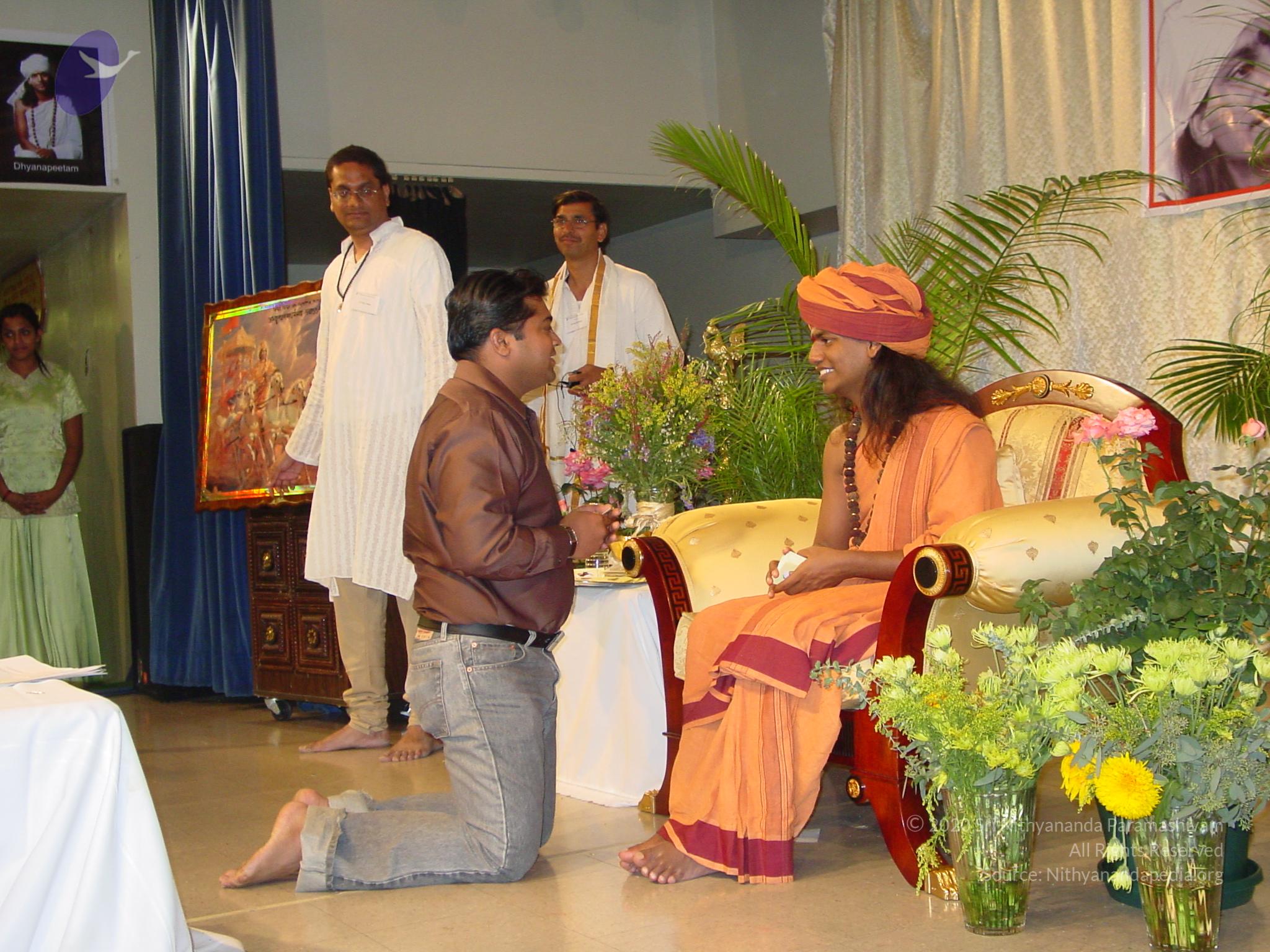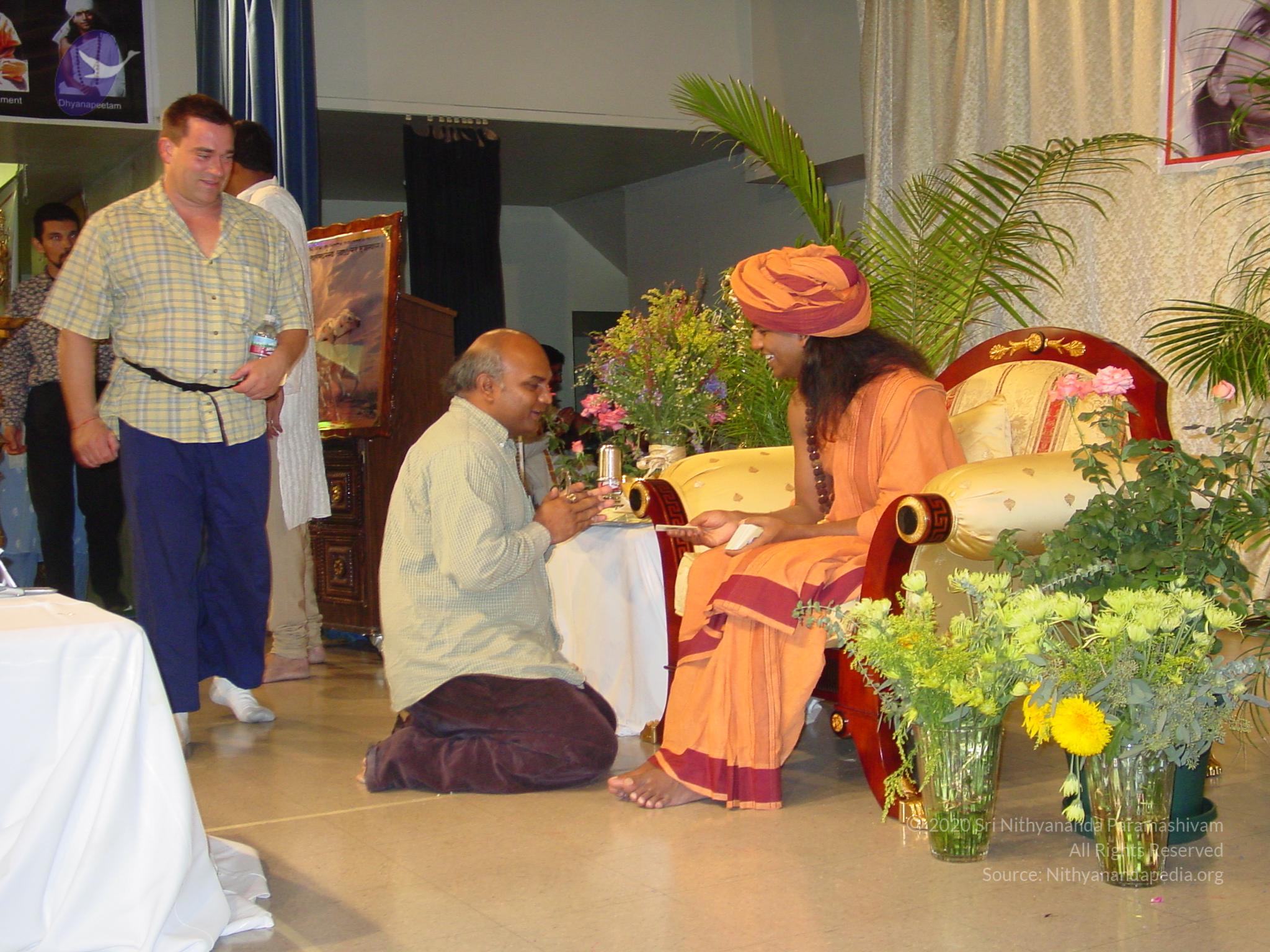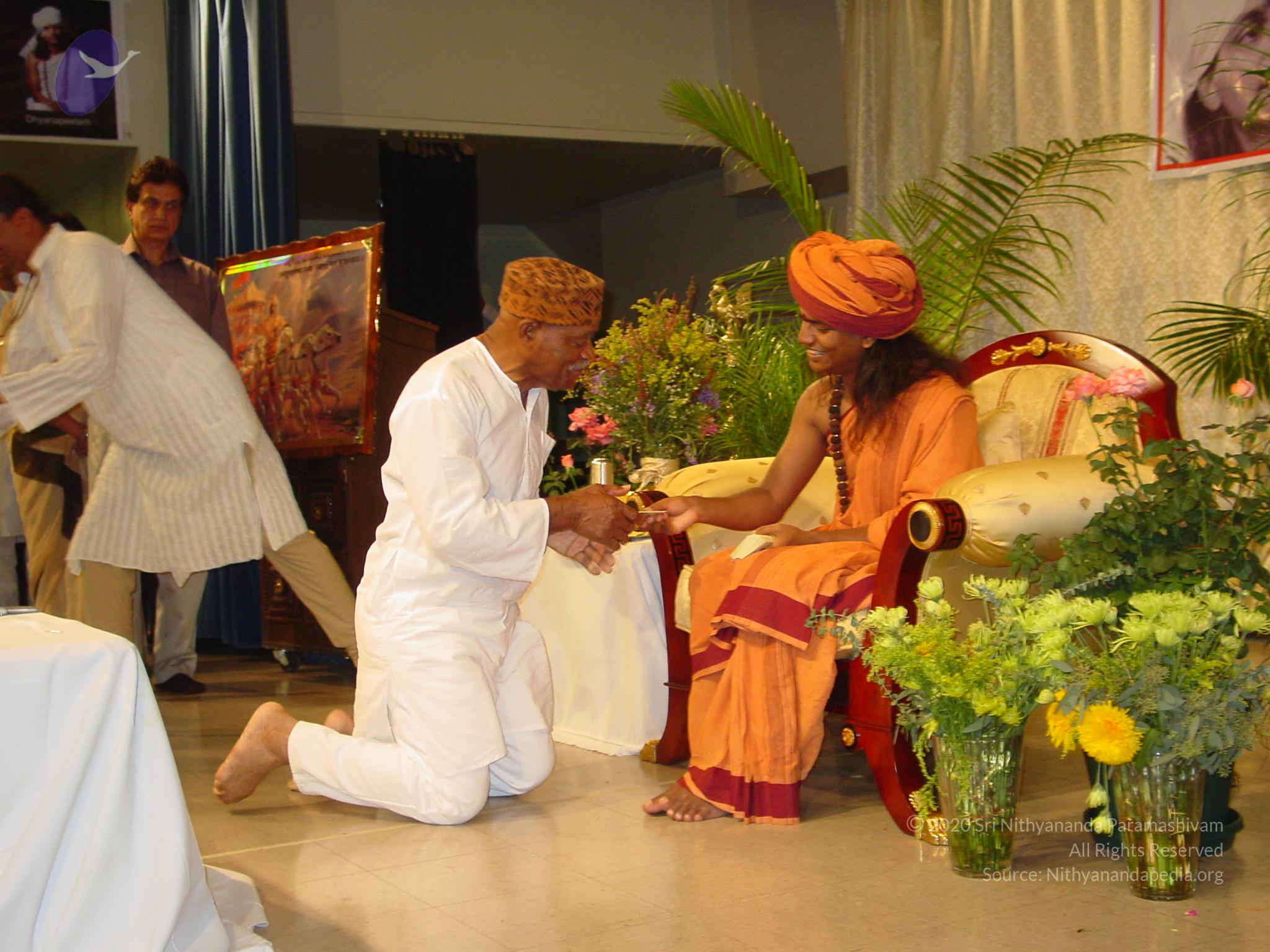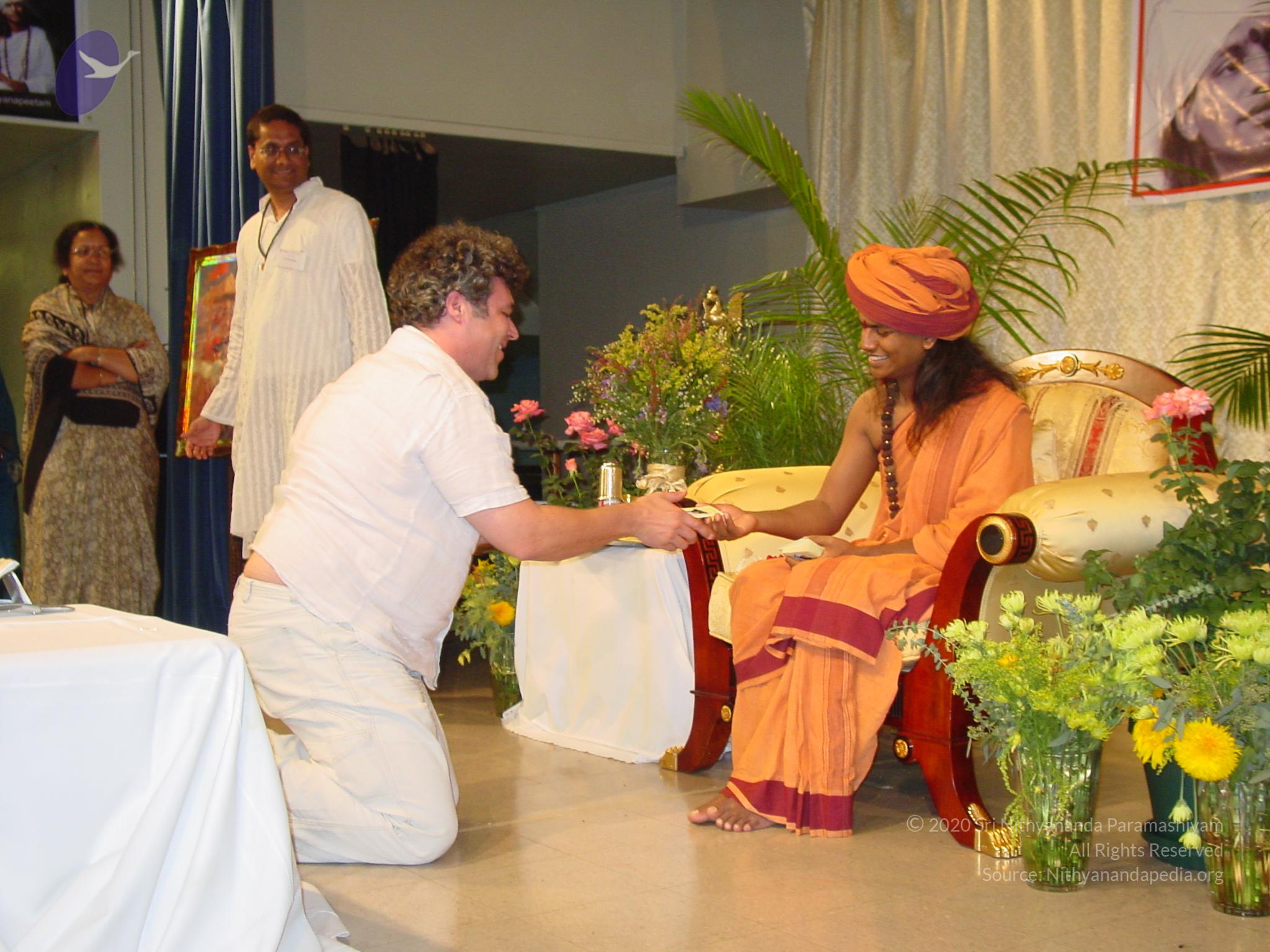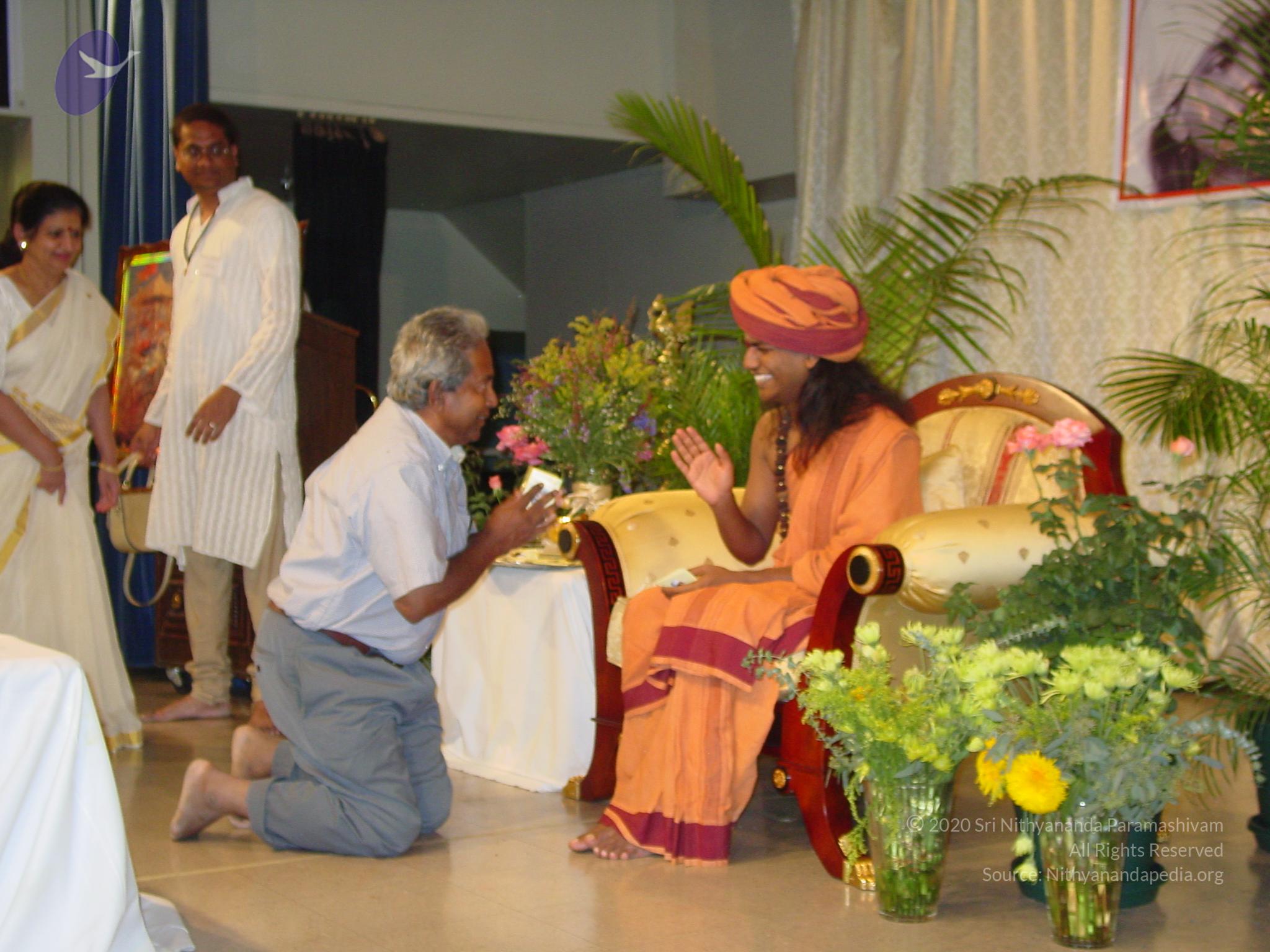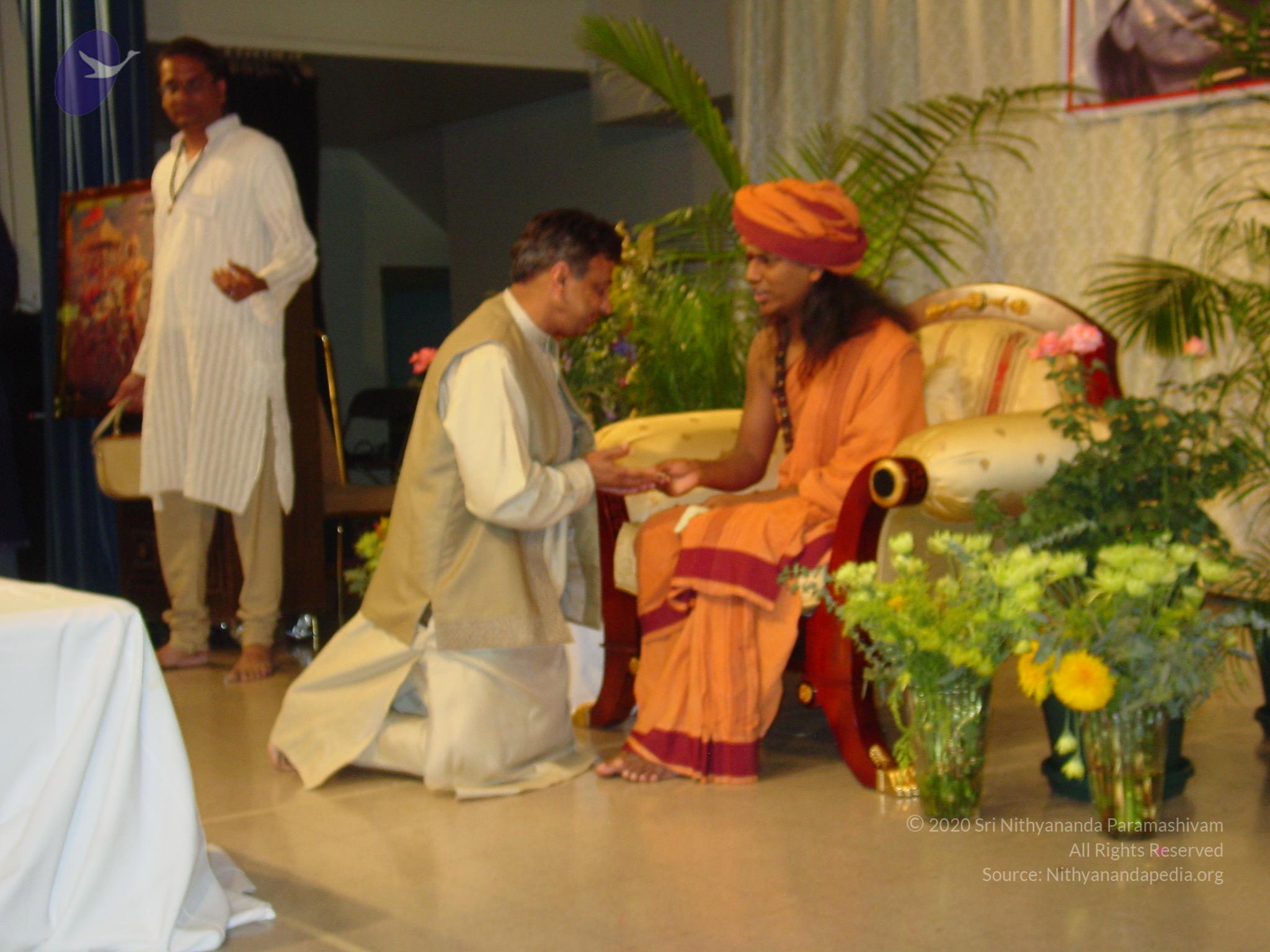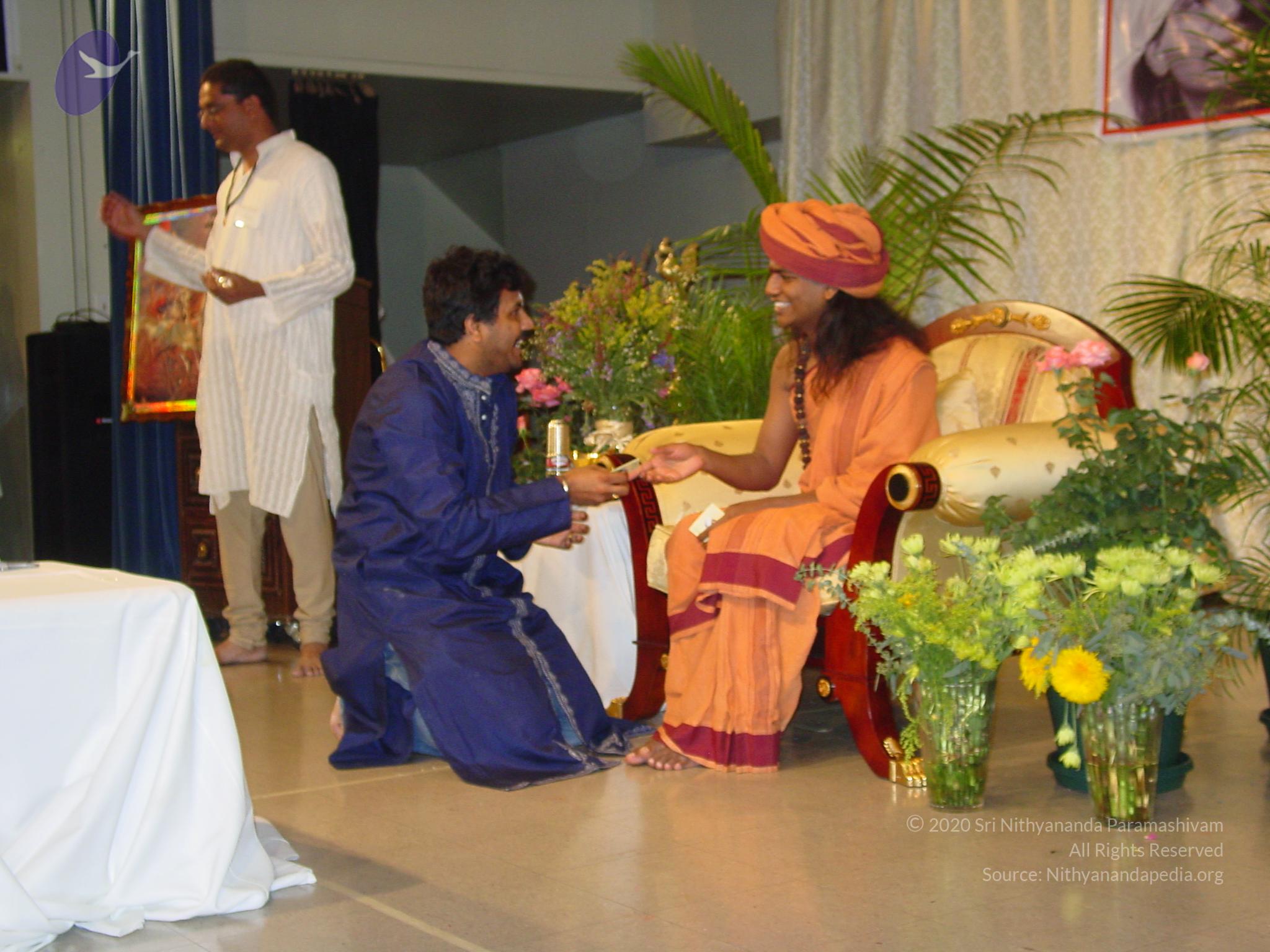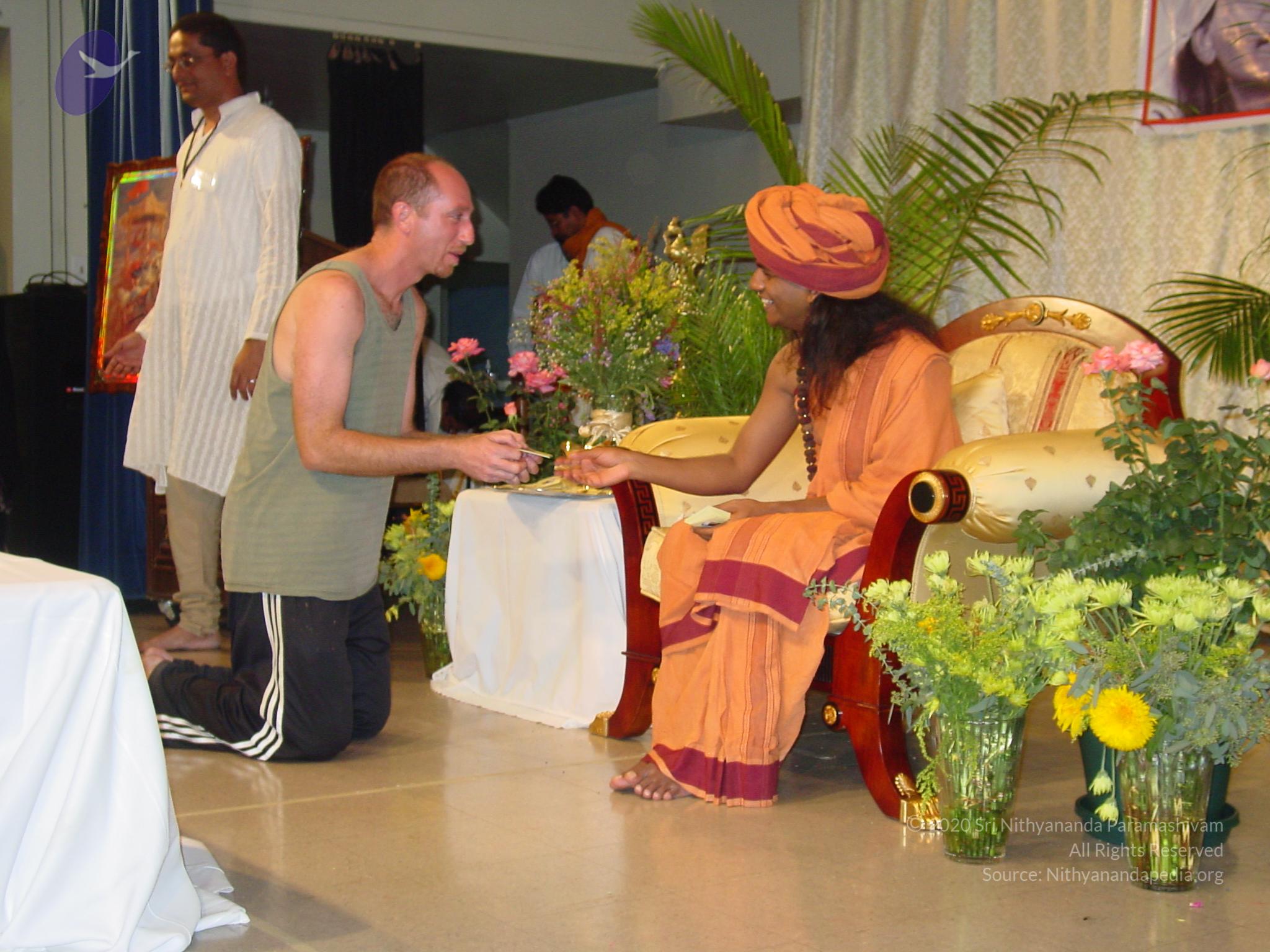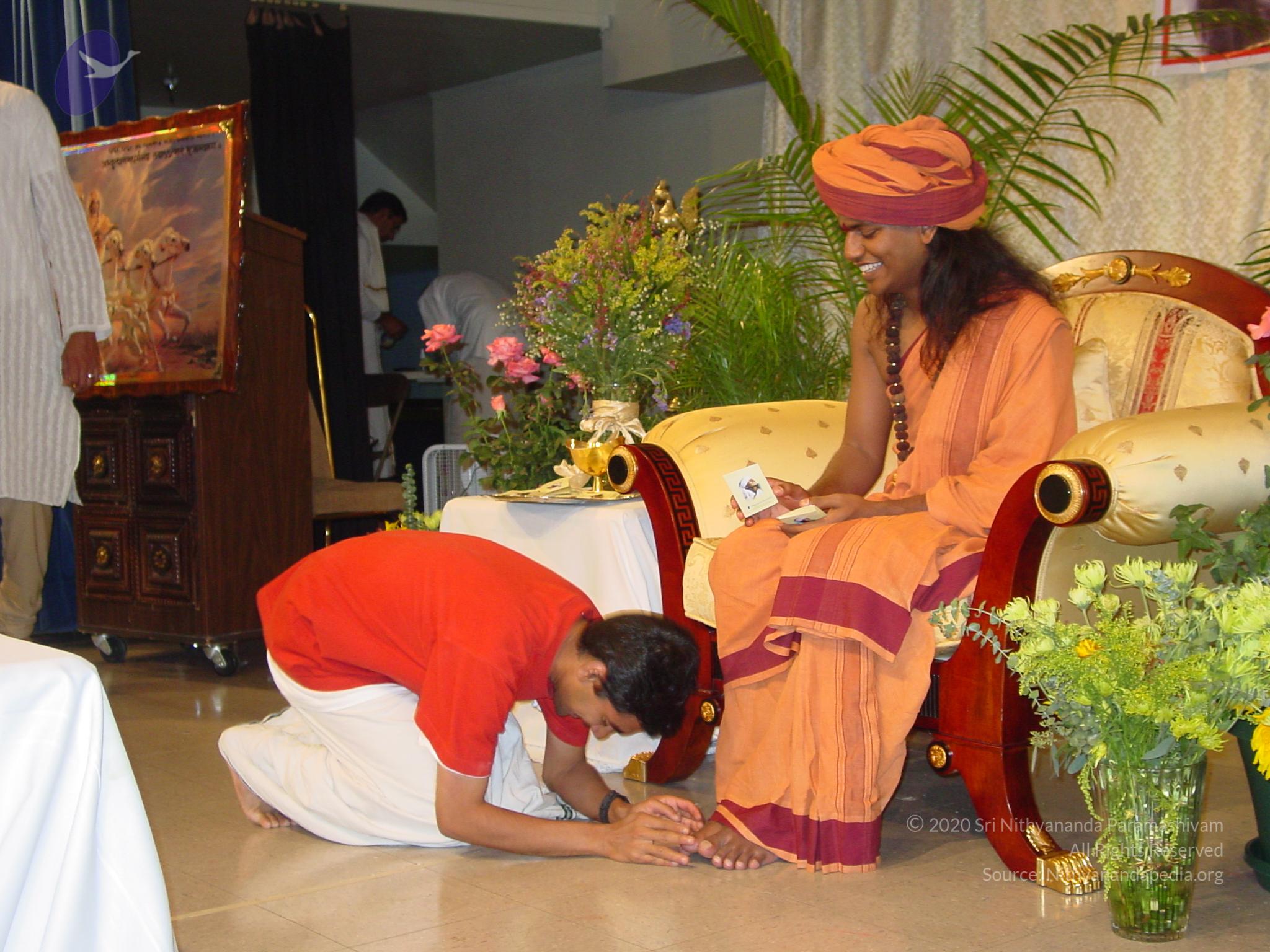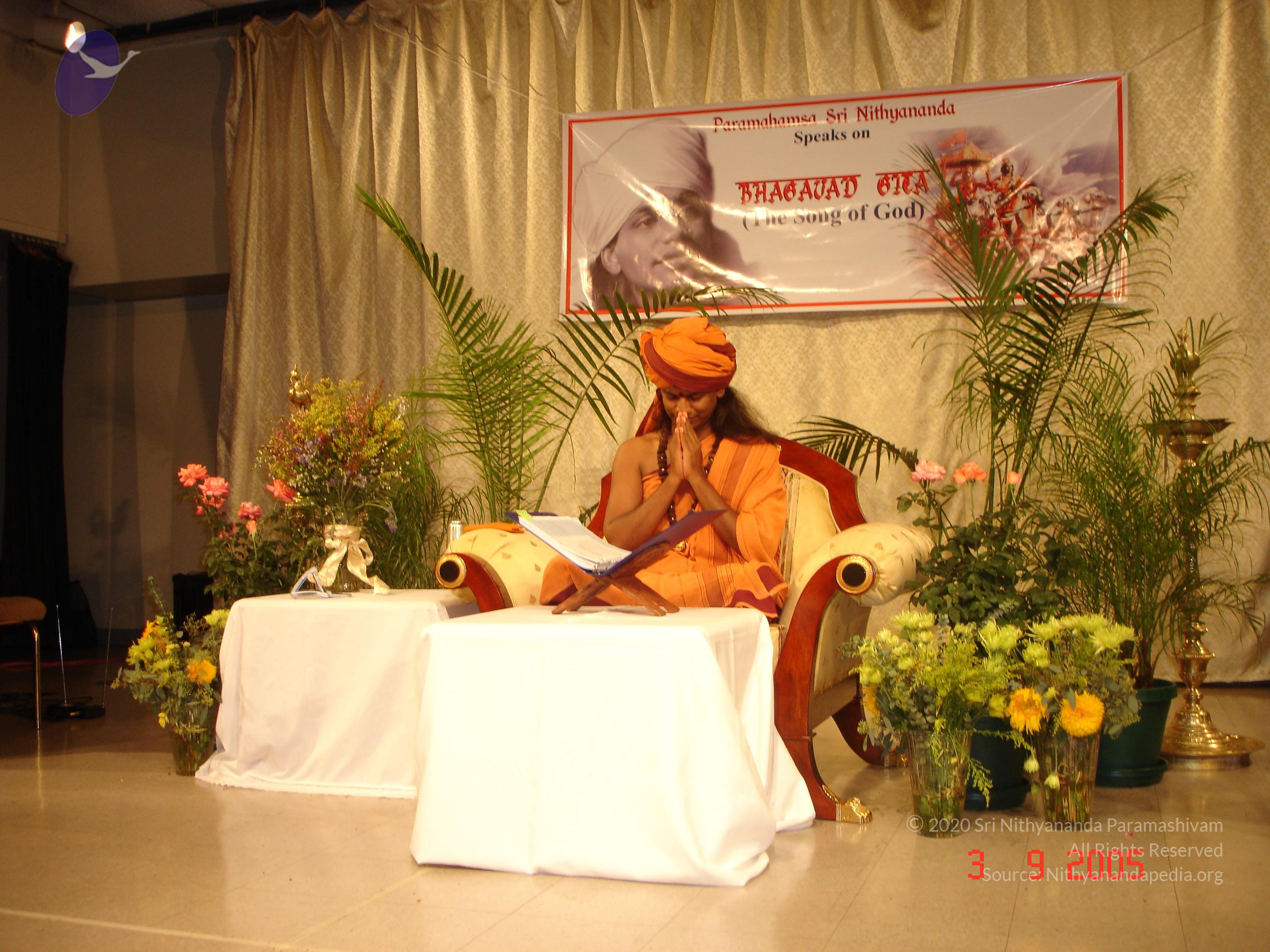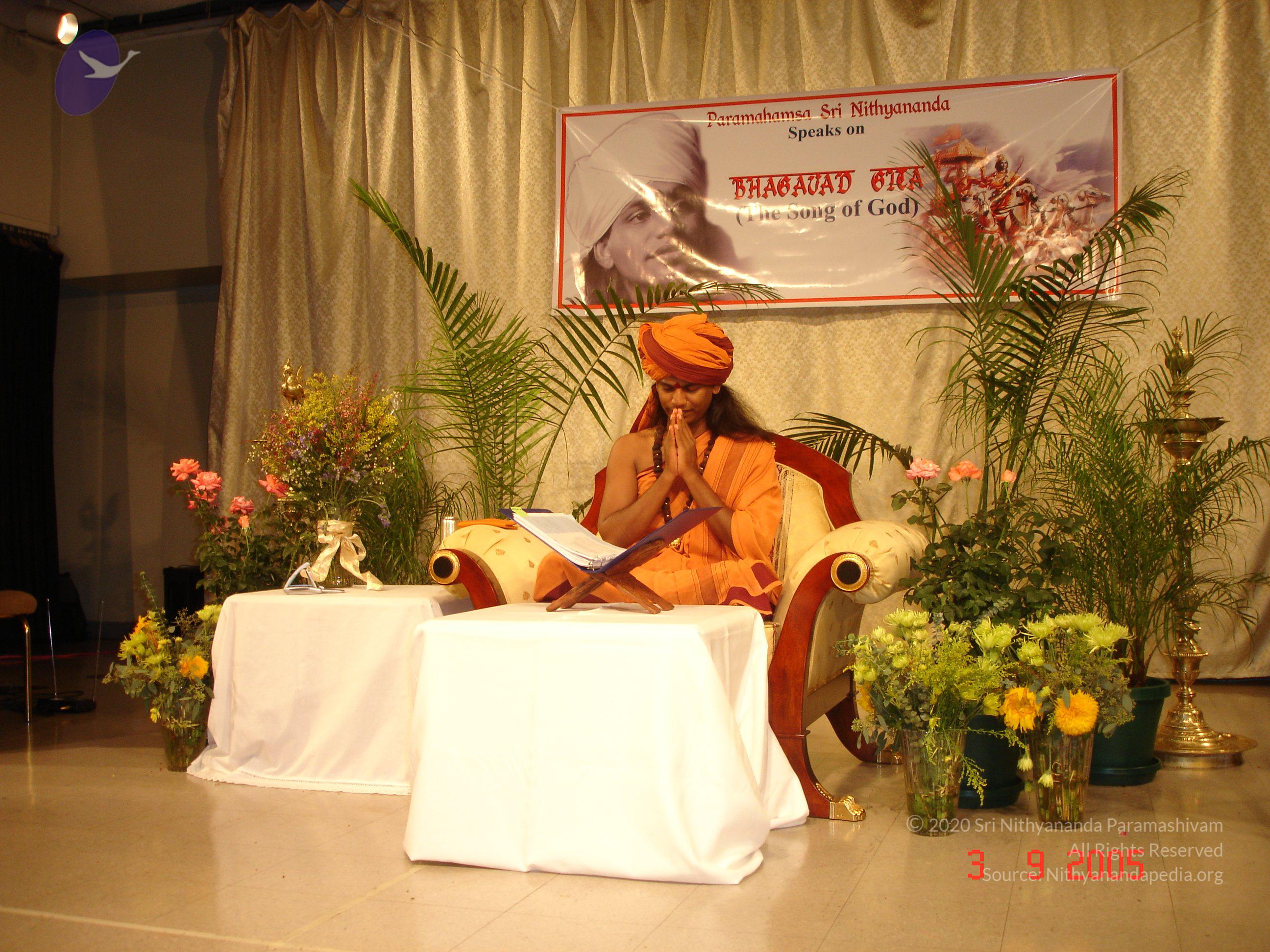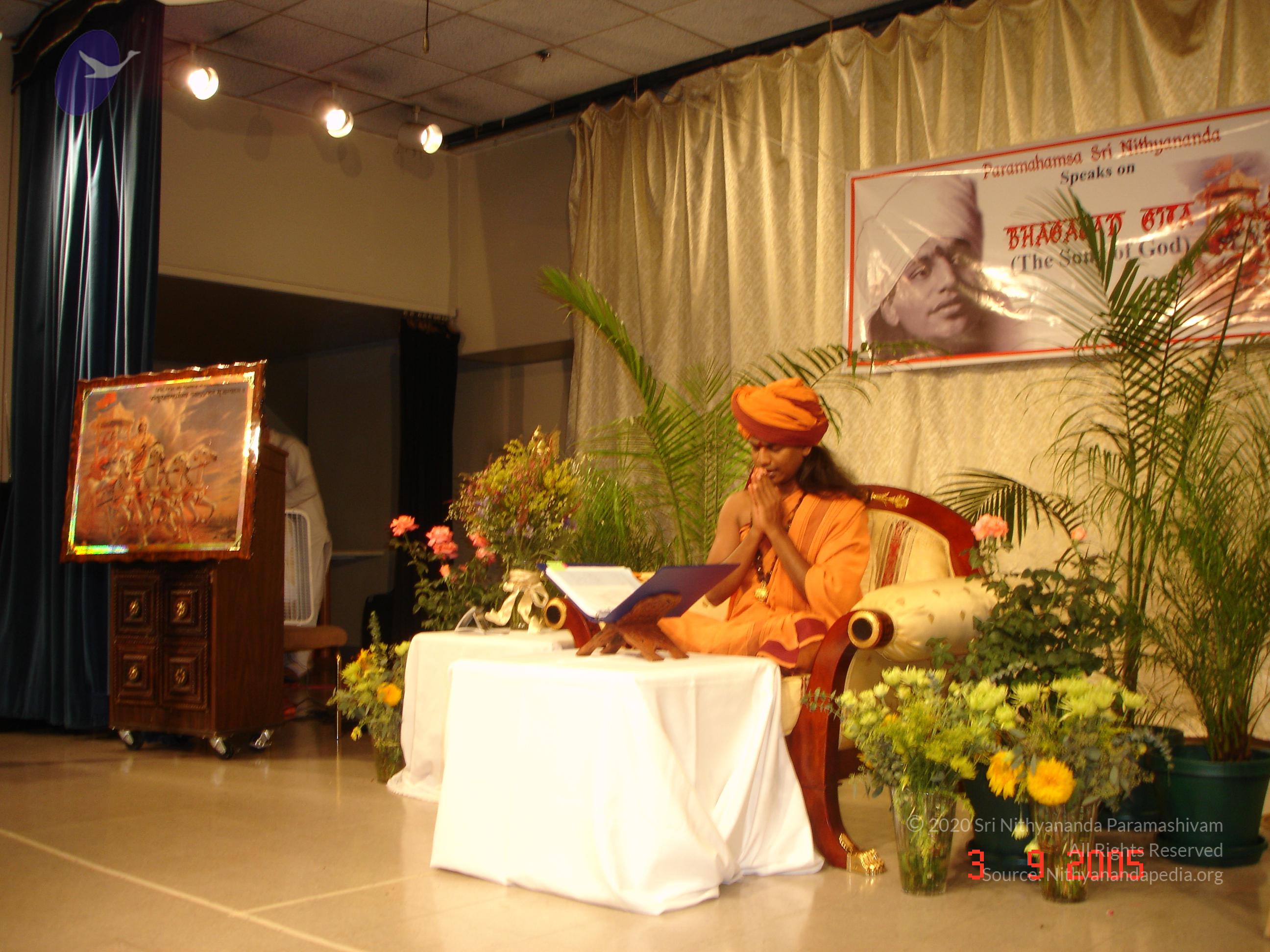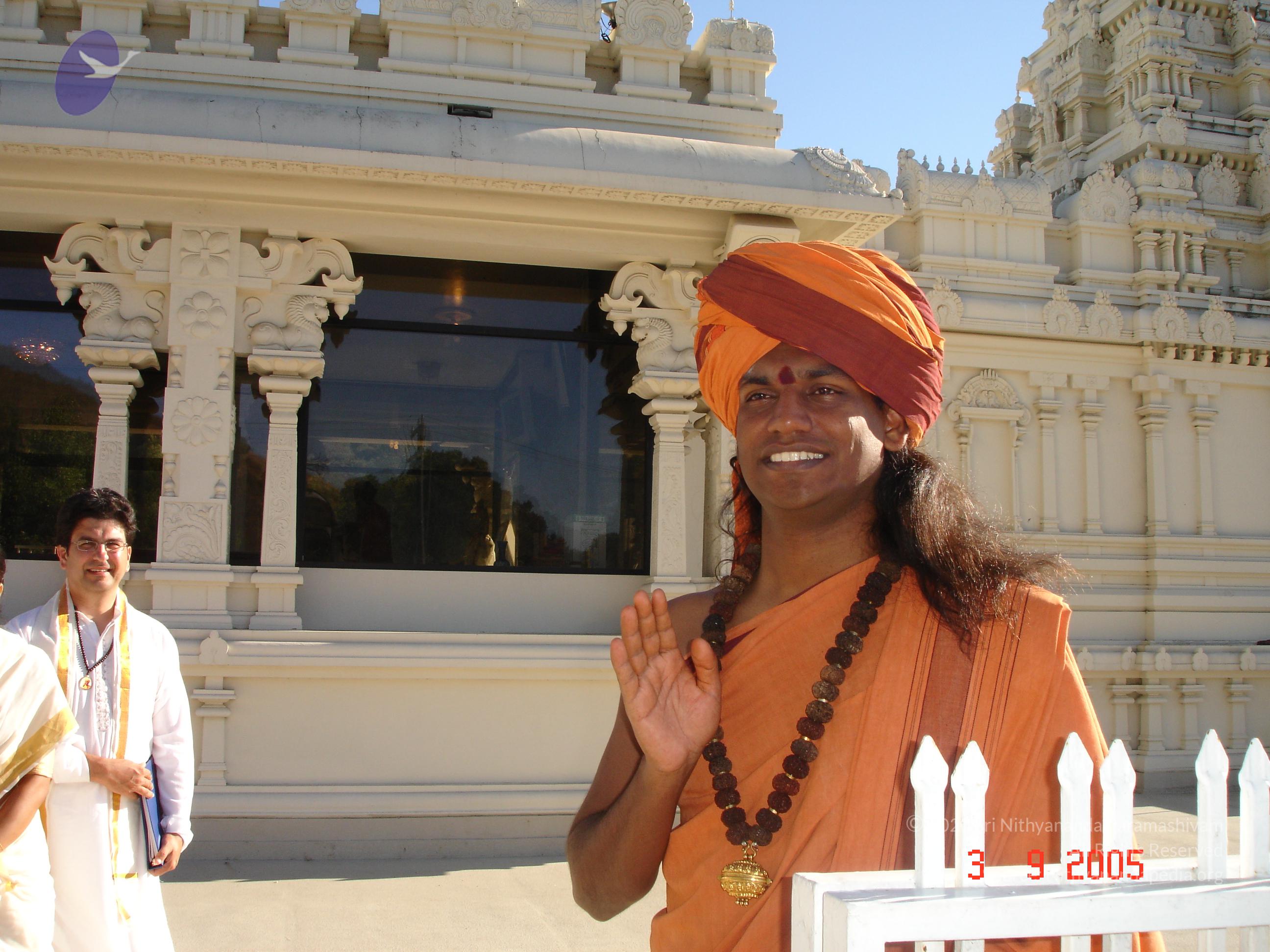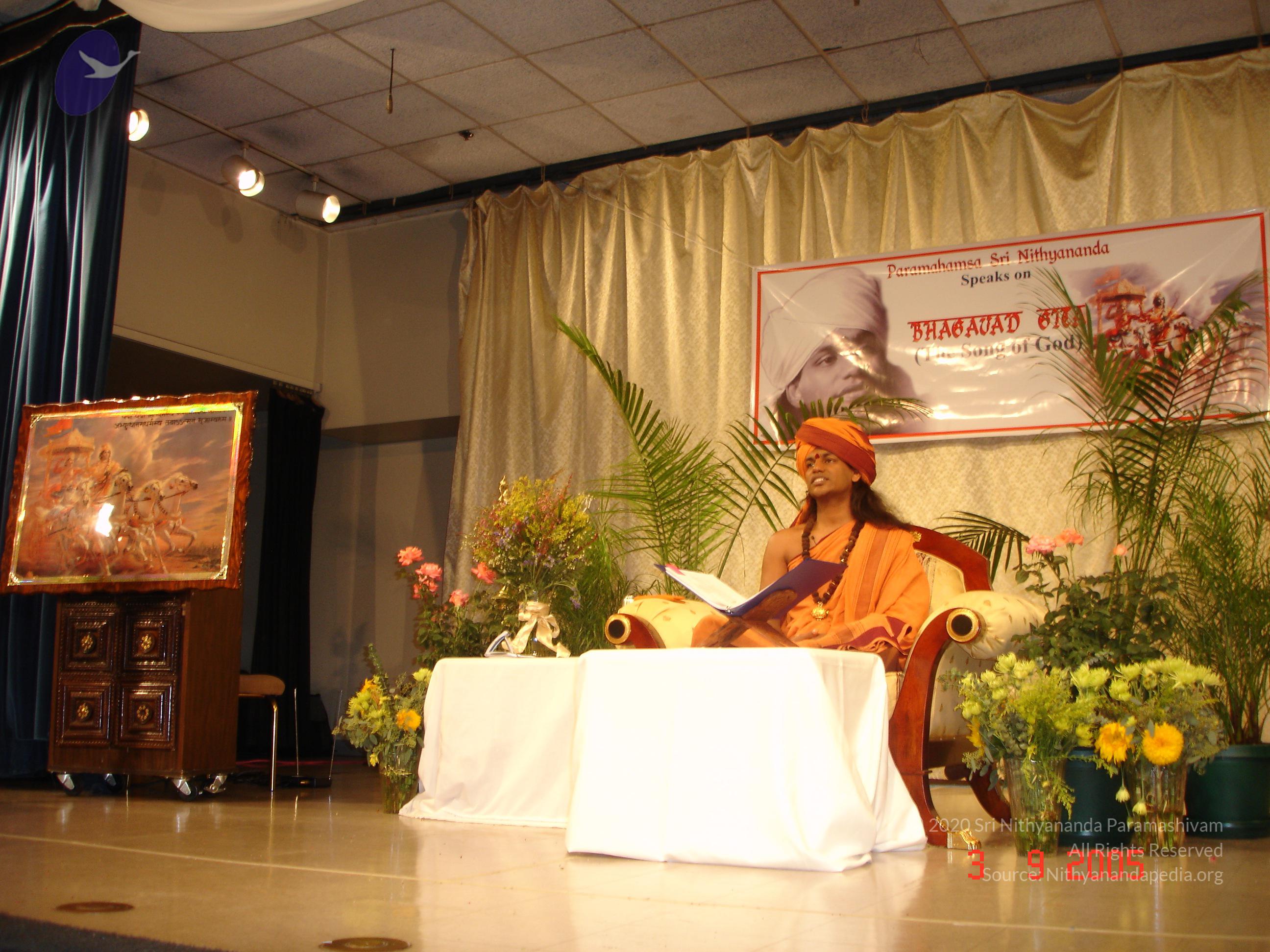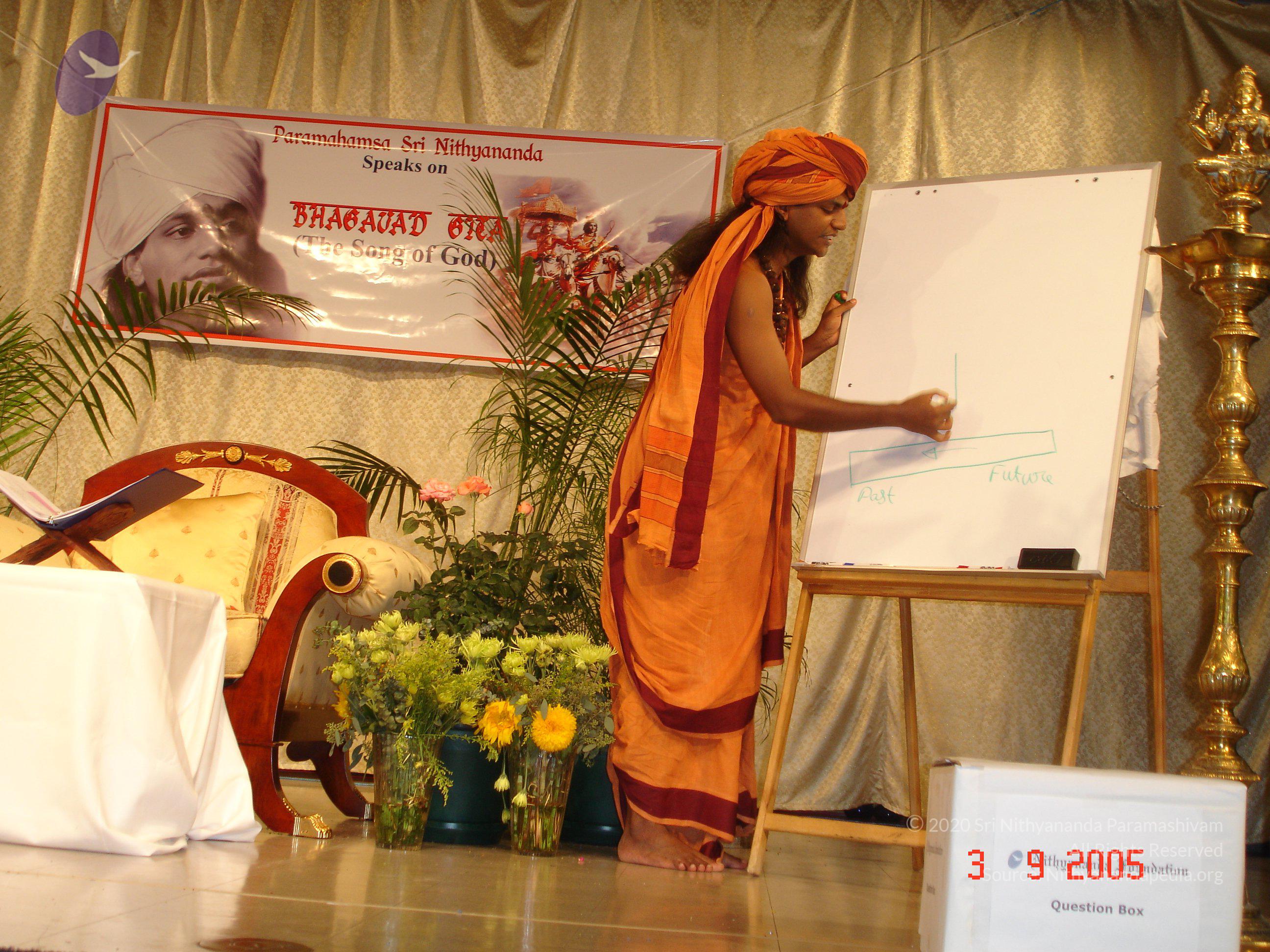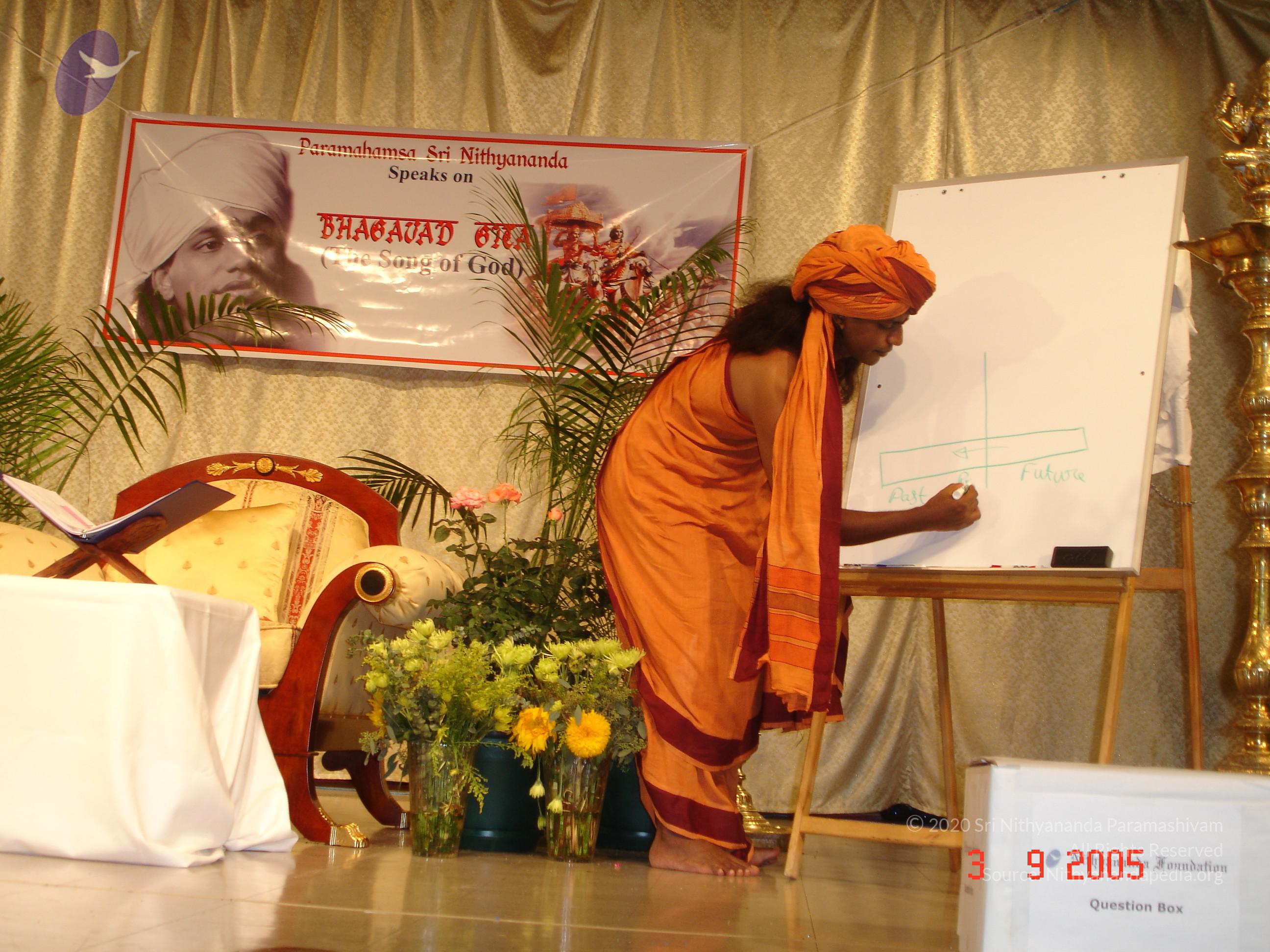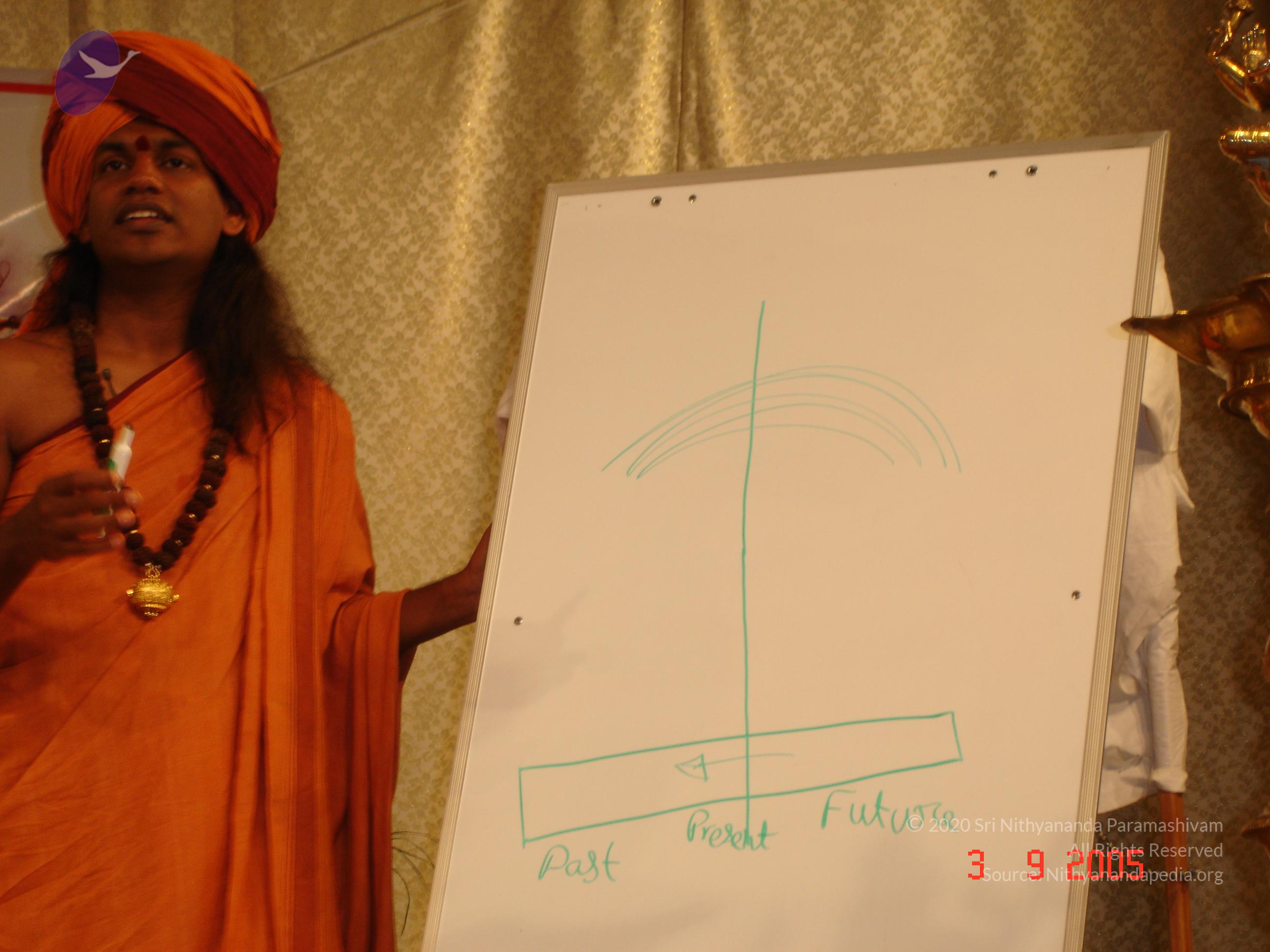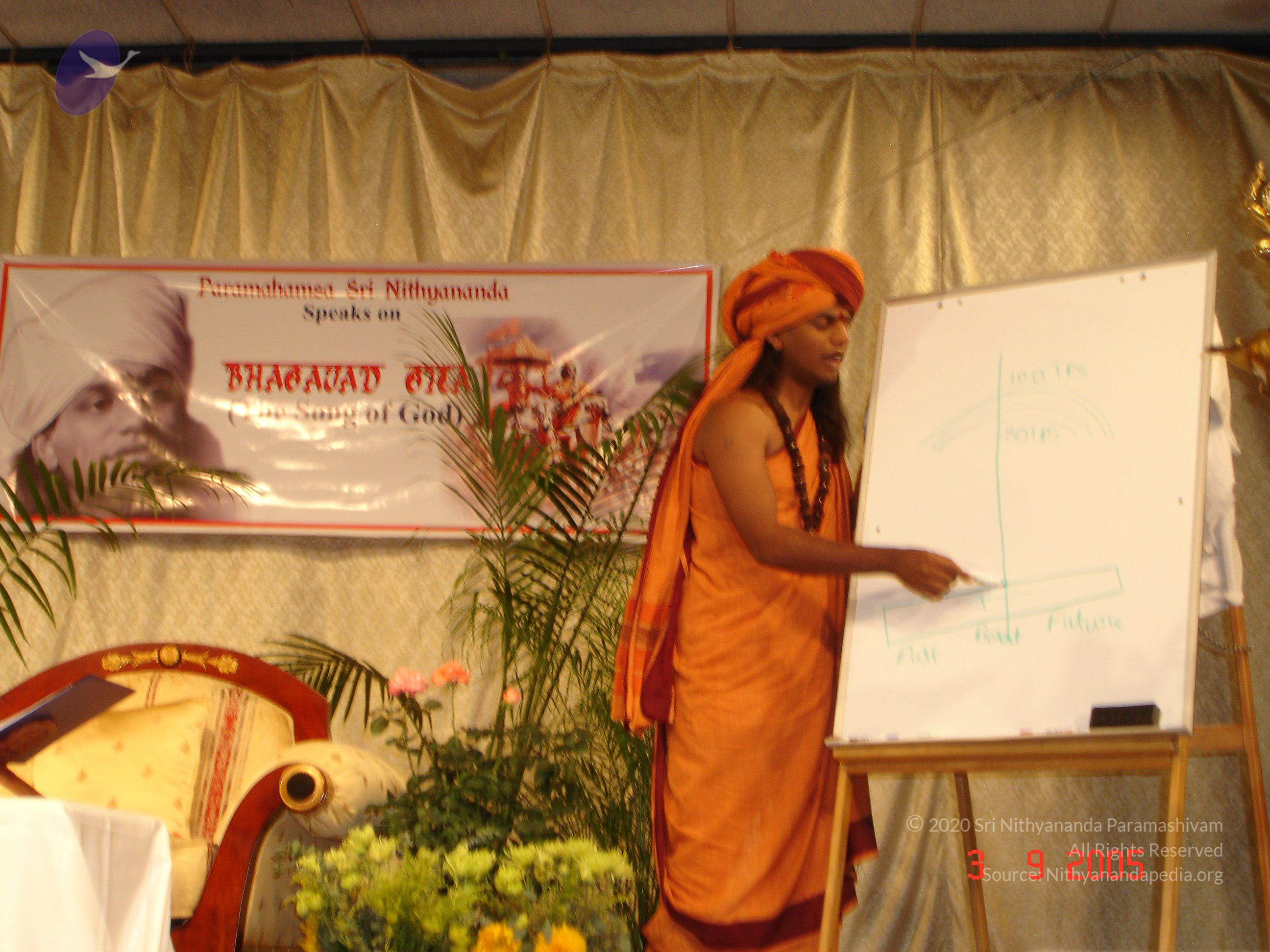September 05 2005
Title:
Bhagavad Gita chapter 2 Part 1 - Nithyananda
Description:
Discourse on Chapter Two of Bhagavad Gita by Paramahamsa Nithyananda in California after the inauguration of Duarte Ashram.
Link to Video:
Audio: Bhagavad Gita chapter 2 Part 1 - Nithyananda
Title:
Bhagavad Gita chapter 2 Part 2 - Nithyananda
Link to Video:
Audio: Bhagavad Gita chapter 2 Part 2 - Nithyananda
Transcript
Bhagavad Gita - 2 (Verbatim)
Om paarthaaya prathibhooshithaam bhagavathaam Narayanenaswayam vyaasenagrathithaam Puraana muninaam madhye mahabharatham Adhvaithaamrudhavarshineem Bhagavatheem ashtadashaadhyaahineem Ambathvaa manasandhathaam bhagavat geethe Bhavatveshineem
I welcome you all with my love and respects. It is today that we enter into the real Gita. It is from today that Bhagavan starts speaking.
Yesterday Krishna as a man was speaking but it is only from today that Krishna as Bhagavan begins to speak.
One thing we all need to understand; only an intelligent man will allow the other person to speak. We all speak continuously but a conversation does not happen. The two are quite different. When the other person speaks we do not listen but are preparing our own reply. You are polite enough to listen so that you will in turn, be heard.
A conversation does not happen. You need intelligence to allow the other person to speak. Please understand you do not need intelligence to speak; you need it only to listen. As an aside, because Bhagavan is a male, he allowed Arjuna to speak !
A small story: A person was telling his friend that he had not spoken to his wife for a whole week. His friend asks him whether he was angry with her or had he fought with her. The man replies, ‘No, I am afraid of interrupting her ‘! You either speak verbally or mentally but are speaking continuously. Why do you think psychiatrists are paid so well? The professions of psychiatry and psychoanalysis are nothing but the art of listening. A psychiatrist is a person who asks expensive questions and just listens, nothing else! You speak continuously; even when you keep quiet, you are not listening.
Here, Bhagavan allows Arjuna to speak fully for one chapter. He keeps quiet seeing the depth of his confusion and depression. He consciously analyses the origin of Arjuna’s thoughts to determine the platform from which he was moving.
It is possible to become a very successful businessman just by studying the first chapter of the Gita.
You can reach the peak in your profession just by learning the art of listening. Once you listen clearly, you will automatically be able to answer and do so clearly.
A devotee once asked me, ‘Master, how is it that you are able to answer so many questions?’ There is only one secret to this question. I know how to listen to the question, that is all. If you know the technique of listening, the reply is immediately ready in your being. First, mentally we do not trust ourselves, rather our intelligence, that we can respond to a question without preparation. That is why we start preparing the reply even before listening to the question. We do not have the patience to listen to the problem. Before we listen to it, we start giving the solution to it. You are only interested in expressing what you know, not in the real problem.
Here Krishna is interested in the real problem and not interested in expressing what he knows. He wants Arjuna to have clarity of mind and is interested in solving his problem.
He allows Arjuna to speak so that He can go to the root of the problem and address the issue. One needs intelligence, or I may say enlightenment, to listen.
Only an enlightened master like Krishna can listen; of the 18 chapters, he listens fully for one chapter.
Even in the second chapter, He allows Arjuna to speak in many slokas. He knows that once He allows Arjuna to express his problems, he would himself find the solution to them.
People come to me and say,’ Master, you know our problems; please give us the answer ‘. I ask them to state their problems clearly. They say,’ you are enlightened and already know of our problems; please give us the answer’. I said, ‘Yes, I know your problem even if you don’t speak, but you will not know your own problem if you do not speak ‘. Only when you verbalize do you actually come to know your problem clearly. Here Krishna allows Arjuna to verbalize, so that to begin with, Arjuna himself has the clarity to understand his problem. Krishna now speaks for the first time as if straightaway opening his being.
Sri bhagavanuvaacha- Kutastwaa kashmalam idam vishame samupasthitam Anaaryajushtamaswargyam akeertikaram arjuna.
Krishna says, ‘My dear Arjuna, how have these impurities come upon you? They are not at all befitting a man who knows the value of life. They lead not to higher planets but to infamy’. This sloka is connected to the next one. Klaibyamaasma gamahpartha naitat twayyupapadyate Kshudram hridayadaurbalyam tyaktwottishtha parantapa.
‘O son of Partha! Son of Chuta, do not yield to this degrading impotence. It does not become you. Give up such petty weakness of heart and arise, O chastiser of enemy’.
I may say that this is the gist of the whole Gita.
Krishna is the true zen master and does not beat around the bush. Understand that He is not a philosopher and addresses the issue straightaway. He asks Arjuna directly,’ how did such impurities come to you? They are not for a man like you. They will not lead you to higher planets but only defame you’. In the next sloka he asks Arjuna to give up this weakness and addressing him as ‘chastiser of enemy’, asks him to arise.
This is a straight zen answer.
A disciple goes to an enlightened zen master and asks, ‘Master, what is buddha? How can I become buddha? Please teach me ‘. The Master gives him a hard slap.
The disciple is shocked as he expected to receive some kind of meditation technique, a blessing or guidance. It was like going to a swami and asking him how to realize God or athman and receiving a blow in return! But the disciple being mature does not speak ill of his master. He says, ‘Master, I know that you do anything with a meaning. Though I am unable to understand the reason for your action, I cannot say it is wrong. Please explain’. The master says, ‘Fool, you are Buddha; why do you try to become something you are already?. If a horse comes to me and asks how it can become a horse, how to eat grass and drink water, what can I do? You are already that and nothing else needs to be added to you. He gives the reply straightaway with a slap.
Similarly, Krishna gives the gist of the whole Gita with one ‘slap ‘. Krishna knows Arjuna’s problem. Please understand Arjuna does not have depression because of spiritual seeking. He does not want a solution, he wants only support.
Understand, asking for solution and asking for support are two different things. What Arjuna needs is support, not a solution. This is why Krishna does not speak of spirituality in these two slokas. Arjuna’s problem originates from fear and worry.
His manipuraka and swaathistaana chakras are blocked. He has a deep fear and worry because of fear. Krishna addresses Arjuna’s deep fear straightaway without any philosophy and asks him to give up his foolish weakness and to get up and fight.
If Arjuna were in a mood of stotra or surrender, to which he comes later on, these two slokas would have served as suthras or technique for him. He would have become enlightened or would have achieved the Ultimate just with these two slokas. The entire Gita would have been encapsulated within these two slokas and there would have been no need for anymore. Neither of us would need to come here for 18 days!
But because he was not in the mood of stotra, Krishna has to create the shastra or method, to bring him to the stotra state. The whole issue is because of fear; worry and depression because of fear. All our depressions have their roots in anxiety and fear.
A small story: A presidential candidate was addressing a press conference, ‘ I am very optimistic about my future’. The journalist asks, ‘Then why do you look so worried? ‘
The candidate replies, ‘My optimism is not warranted. I am just worried ‘.
We constantly expect our optimism to be warranted. When we do not get the warranty, we start worrying. All your depression, worry and anxiety is nothing but a deep fear of life and of losing something.
There are many levels of fear: fear of losing your wealth, fear of losing a limb, fear of losing your near and dear ones, fear of the unknown or death.
Here Arjuna is confronted with all the four fears; fear that he may lose whatever he possesses or that he may lose a part of his body in war; third, a major fear, that he may lose his near and dear ones and fourth, the possibility of his losing his very life.
These fears have in turn, led to his worry. Here Krishna directly addresses the worry and fear. Had Arjuna been in the stotra state, that is, in the complete understanding that Krishna is but God , poornaavathara, these two slokas would have been enough and no further instruction necessary. But unfortunately (rather, fortunately, as otherwise we would not have had the Gita ) as Arjuna was not in the state of stotra, these two slokas have become shastras. Now the shastra starts.
At the 11th chapter after the vishwaroopa darshana Arjuna realizes who Krishna truly is , that He is beyond everything , beyond his imagination, that he is not surprised why all the devathas worship Him and surrenders to Him. Krishna then repeats the same words that he has now said after which Arjuna starts the war and the Gita ends. The same words uttered by Krishna when Arjuna is in the state of stotra, becomes a sutra, a technique, for him. Now that he is not in the stotra state, these words are plain shastra. Krishna is not a philosopher. All philosophy is an attempt to convince the other to do what the philosopher wants of him. It may be a very slow process but still a process of trying to convince the other person of what to do. Hitler, in his autobiography says that if a lie is repeated a hundred times, it becomes the truth and if a truth is expressed for the first time, people think it is a lie. Whether something is true or false does not depend on the fact but on how many times it is repeated! All philosophies, whether they are of communism or religion or politics, are the same. The philosophers invent logical reasons why you should follow their words. Here Krishna is not a philosopher and does not want to create any philosophy. He directly tries to give the conclusion to Arjuna. But as Arjuna is not in the mood to receive it because he is not mature enough to assimilate it, He needs to give Arjuna the experience.
There is a beautiful story in the Upanishad: A disciple goes to the Master and asks,’O Master! Teach me atmagnanam’.
The Master says, ‘that art thou! tatwamasi, you are God ‘. The disciple, unable to believe, thinks, ‘how can I be God? Iam still afraid of my wife, have all the problems and a thousand questions! When the Master proves to him that he (the Master) is God himself, the disciple trusts the Master’s words. The Master needs to first prove that he is God, in order to make you understand that you are God. Here Krishna does the same thing by repeating that He is all of this. Among the rishis He is Narada, among the months He is Maargashirsha. He explains His glory that all the devathas, the vedas are at His feet and the whole world in Him. He makes these big statements which to a normal person would appear as egoistic. Thus Krishna repeats that He is God, to make you realize that you are God. He makes the statement, ‘I am God’ just to make you realize that you are God. You do not believe the words of ordinary persons. You need to hear the words from a source of authority that has the right to say them. Here Krishna says the same words that he repeats in the entire Gita but now Arjuna is not able to believe His words. Once Krishna proves His divinity, Arjuna believes His words and is ready to follow them. Similarly when Masters prove their divinity, perform great deeds or miracles, they do not do so for their ego- satisfaction. They do them to prove that they are God, so that you believe their words and experience that you are God. This is the reason why Masters repeatedly prove their divinities through their energies. A great author wrote a book of just 40 pages giving the gist of his philosophy. A reader asks him why the book was of only 40 pages to which he replied that if he had the time, he would have written a book of only 20 pages ! It requires intelligence to put anything in simple form or in a nutshell. To go on and on, not much intelligence is required. Only fools write big volumes! Intelligent people express the same contents in a few words. Here all the 700 slokas of the gita is reduced to just two slokas by Krishna. He straightaway addresses and clears the point where Arjuna is stuck: name and fame or rajas. A man, who is centred on satva, will work out of compassion; a man, who is cented on rajas, will work only for name and fame; the man who is centred on tamas, will work only for sensual pleasures. Duryodhana works only on tamas, cruel and gross. Dharmaraja works on satva, out of compassion. Here Arjuna is centred on rajas, therefore works only for name and fame. This is why Bhagavan asks him not to work this way as it would bring him (Arjuna) bad name. This is how He straightaway puts his hand on the tumor. Fortunately, Arjuna is not intelligent enough, rather, acts as if he is not intelligent enough to understand these words. He has lived with Krishna for more than 30 years and must have intelligence; he puts these questions for the future generations.
Klaibyammaa smagama paartha naitat twayyupapadyate Kshudram hridayadaurbalyam tyaktottishtha parantapa
Krishna again comes to the point straightaway. He is not creating a philosophy and does not beat around the bush. He emphasizes, ‘O Arjuna! Lead not into this debasing impotence, do not behave like this, come out ‘. A small story I read in the Newsweek: There was a person who had a compulsive, obsessive habit of tearing up into small bits whatever paper he saw or laid his hands on. His family was worried and took him to Jungians, Freudians and psychoanalysts. They spent a lot of money and tried all possible kinds of treatment but nothing worked. One day they read about a young and innovative psychotherapist in the newspaper and decided to try him. The therapist said he wanted to spend a few minutes alone with the patient. He and the patient simply walked up and down for a few minutes after which the therapist returned and pronounced that the patient was now cured of his malady and could be taken home. His family was surprised when they found that he was really cured. Even after a year he was found to be perfectly alright. No one however, knew how the problem had disappeared. The family returned to the doctor to express their gratitude. They wanted to know what the doctor had really done to cure him of the problem which others could not achieve. He replied that he simply asked the patient not to tear any more papers and if he did so even once more, he ( the patient) would be brought to him ( the doctor ) again , whereupon he would be thrown out of the window ! Most of the time, our problems are very simple; we complicate them by analyzing them. When you verbalize and analyze a problem, you complicate them and give power to them. Your problems are not as big as you think. When you verbalize, analyze, label and categorize them, you have created a whole new problem which had not existed earlier in your being. This is how psychiatric doctors continue to invent newer diseases! The more you analyze the more problems and difficulties you create. The simple, direct approach of the young doctor above solved the problem which detailed analyses and lying down on couches could not. You have only one mind – you can either use it to solve the problem or it would naturally get used to create more problems. Understand that if you are not solving your existing problems, you would be creating more problems. In the level of the mind, there is no position of simply standing, no status quo – you either climb or fall. Here Krishna straightaway addresses Arjuna’s problem. One more small story: A man walks into a bar with his pet pig. The bartender notices that the pig has a wooden leg. He is surprised that a pig is brought into the bar and that too, one with a wooden leg. He asks the customer about the pig’s wooden leg. The man realizes that he could encash on the bartender’s curiosity and replies that if he could get a free drink, he would relate the whole story. The bartender agrees. The man after the first drink said that this was a special pig who had saved him, his wife and his family when his house was on fire. The bartender nods but says that he still cannot understand why the pig has a wooden leg. The man replies that he can continue the story if he got one more free drink.
The bartender agrees. The man says when he fell into a lake, the pig had rushed to his wife, called her and he was saved again. The bartender could not take it anymore; he said he understood that the pig was special but still did not know why it had a wooden leg .
The man asks for one more free drink. The bartender agrees to give one last drink.
The man began the story of how the pig once again had saved him from a tornado, but the bartender would have no more of it. He caught hold of the man by his neck and demanded why the pig had a wooden leg. The man replies calmly, ‘Such a special pig! Who would eat it all at once? I’m eating it part by part! So, the man narrated the whole thing as a story which he could have finished in just one line. He must have been a great philosopher!
Here Krishna is not creating any philosophy and gives the answer straightaway in just one line. But as Arjuna is not mature enough, He has to give an intellectual explanation.
All western philosophies begin with logical analysis and end in the conclusion; all eastern
Darshanas begin with the conclusion and then give the analysis. As the eastern masters are compassionate, they do not want to torture you with all the logic. They give you the first option of grasping the solution if you have the intelligence. If you do not have the intelligence, they have no other option but to go into detailed explanation and analysis.
They expect you to transform with just the trust but start the regular process when they find that you do not have the qualification.
Here Krishna tried the first method of sudden enlightenment, the immediate liberation.
But Arjuna is not mature enough to receive it or comprehend it. So Krishna now starts the process of explaining it to him step-by-step.
Arjuna uvaache- Karpanyadoshopahataswabhaavah pricchaamitwaam dharmasammudhachetaah Yaschreyansyaannischitam broohitanme shishyaste’ham shaadhimaam twaam prapannam.
Arjuna says,’ Now I am confused about my duty and have lost all composure because of miserly weakness. In this condition, I ask you to tell me for certain what is best for me. Now I am your disciple and the soul surrendered unto you; please instruct me ‘
I must now tell you an important truth. Here Arjuna says, ‘my soul is surrendered unto you’. This is a lie. Had his soul been truly surrendered to Krishna, he would simply have followed whatever Krishna said and would not have waited for intellectual explanations. I have seen many people in the same situation.
A small story, rather, a piece of history- One night around midnight I got a call from one of our devotees who was a government officer pleading for my help from a serious problem. He said that if he could not have my help, suicide was the only alternative for him. I asked him to come the following morning and that we would do whatever had to be done to take care of his problem. He however, insisted on a solution right then. After going into detail about the problem I assured him that his problem would be taken care of but that he come in the following morning anyway, so that the problem could be analyzed properly and ensure it did not repeat itself. He replied that coming in the morning of the following day was not possible because he had to go to work!
When he was speaking of his problem he said his life itself was at my feet and that as my disciple he had surrendered completely and only I could save him. But when I asked him to come on the following day, he said he had to go to office! Arjuna is in exactly the same position. He says his soul is surrendered to Krishna but when Krishna asks him to do His bidding, he is not ready to do so and is confused.
Surrender out of confusion, is not surrender as you do not even know if you are doing the right thing. Understand, surrender after the clarity of shastras or intelligence, is true surrender, and not surrender out of confusion. Here Arjuna surrenders verbally as he himself says that he is confused. You must either do what you think is right or do as the Master instructs. Here Arjuna wants the Master to instruct what he wants to listen, not what the Master says. So, though he says he has surrendered, he has not done so.
But out of karuna or compassion, Krishna continues to express and teach him the truth.
Here begins the shastra. The two slokas which Krishna spoke are sutras. But as Arjuna is not ready to receive them, he has to commence the shastra.
Sri Bhagavan uvaacha- Ashochyaan anvashochastwam prajnavaadaamscha bhaashase kataasoon akataasoonscha naanushochanti panditaah
(Even though it is written here in the past tense, I feel Krishna should always be addressed in the present tense; He is still relevant. We cannot say,’Krishna was’ but ‘Krishna is’; not ‘Krishna said ‘but ‘Krishna says’).
While speaking learned words, you are mourning for what is not worthy of grief. Those who are wise, lament neither for the living, nor for the dead. Again Krishna addresses the issue directly, ‘O Arjuna! You speak as if you are intelligent, enlightened. But your emotion, your being shows that you are not. A really enlightened person will never worry for the living or the dead ‘. If you worry for somebody living or dead, you cannot be a man of intelligence. What is death and life after all? There are thousands, rather, millions who have lived and gone.
Somebody once asked me why natural calamities happen;why so many people die in wars and calamities; why is God doing these things ?
I told him,’ To give you an honest answer, I do not know ‘. But if you insist on an answer, I can give you an answer the next time God calls for a conference! These questions have no answer in existence. The question is asked from a very low level, from your logic. But God is beyond your logic. You can never have an answer for these questions. For example, a small ant asks the elephant, ‘Why are you too as dark as I am? How is it we both have the same colour of skin? Will the elephant be able to answer?
The elephant will not even know that it is being asked this question. Likewise it is important to understand the rules of Existence, of the Divine. Only fools worry about people who are living or dead. A truly intelligent man does not bother about death.
The next sloka; here begins the essence of the whole gita- Natwevaaham jaatunaasam natwam nemejanaadhipaah Nachaiva nabhavishyaamah sarve vayamatah param Never was there a time when I did not exist, nor you, nor all these kings, nor in the future shall any of us cease to be. This is the gist of the whole gita. If you can understand this sloka, you can become enlightened straightaway and enter into Eternal Bliss. Krishna says there was never a time when I, you and all the kings did not exist. If you think our souls will also die with our bodies, you are wrong. We were there before our birth and this death and will remain after death .This is also not true that any of us will not be in the future. In Zen Buddhism there is a beautiful meditation technique to achieve enlightenment. You are asked to meditate on the face you had before your birth. Then you realize that you existed in the past, exist in the present and will exist in the future. Your face and body may change but you continue to exist. Then why do we think we shall die and why do we fear death? If what Krishna says is true, why are we worried about this life and about death? May you first understand the concept of the past, present and future to enable you to understand what Krishna says. I shall try to explain this concept and the athman by means of a small diagram. Time is like a shaft continuously moving into the past (draws) - here is the future, here is the past. The future is continuously moving into the past; every moment and every second it is turning into the past. The present is the point where the future and the past meet. Your mind as such, is nothing but movements between the past and the future. Understand you cannot have any thoughts if you stop thinking about the past and the future. Your thoughts consist of nothing but the constant movements between past and the future. The more your thoughts shift from past to future, the higher the frequency of thoughts. The less you shift from past to future, less the number of thoughts. Try to think of something in the present, you will find that you cannot; you can think of it only by taking it into the past. You are either worrying about the future or remembering the past. The higher the frequency of thoughts, the grosser you are. For example, if you have 100 thoughts per second (TPS), it means you have jumped 100 times between the past and future and from future to past. If you have 80 TPS, you would have jumped as many times between these two dimensions. The more the frequency, the more you would be away from the present. The higher the frequency, the more worries and problems. If the number of thoughts reduces, you fall into the present moment. When your frequency of thoughts is high, you think you are the body or the annamaya kosha. When the frequency is a little less, you move into the layer called praanamaya kosha. When your TPS is say 60 (here the reference is just proportional ), you move into the manomaya kosha and come a little close to the athman. If you fall in the present moment, you are athman. The past, present and future, all the three put together is Eternal, nithya or athman.
Only when you come to the present moment, you experience athman. But as of now you are constantly shuttling between the past and future. The Upanishad talks of five layers; the vignaanamaya and the anandamaya koshas in addition to the three koshas described above. The vignaanamaya kosha is the layer where the TPS is still less, say 40. When your TPS is say 20, you come to the anandamaya kosha. Understand when the number of thoughts grows less, you will not even be aware of the passage of time. For example, when you are with someone you love, even 2 or 3 hours will seem like a short while. On the contrary, when you are with someone whose company is boring, even a short time seems very long; you keep glancing at your watch and wondering why the time does not move!
Understand, time is more psychological and not chronological. That is why in our scriptures or Vedas, we have the word, kshana . This does not denote a second, but the gap between two thoughts. When your TPS is less, you will naturally be in ecstasy, in bliss. When your thoughts are less, you will not know how much time has passed and you are naturally in bliss or heaven. When the number of your thoughts is high, you are in hell.
Hell and heaven are nothing but number of thoughts, that is all.
With higher frequency of thoughts, you are in hell, caught in the physical layer; you think you are the body. When frequency of thoughts reduces, you think you are mind and just emotion and bliss. When the thoughts become zero, you realize you are athman, you are there in the past, present and future. Only a man whose TPS is zero can realize what Krishna says, ‘You will be there forever ‘. The past, present and future are just words; you exist throughout. But right now, the frequency of thoughts is very high. You do not have the patience or the energy to understand who you are, your base and your nature. The moment you fall into the present moment, you experience that you were there in the past, are in the present and will be in the future. Krishna says, ‘you were there in the past, you are in the present and you will be in the future; you do not die ‘. When He says that, he means that you are nithya athman, Eternal Consciousness, you are beyond your mind.
But you are restless and know only this space of moving from past to future, that is why you are unable to believe that this space of the present exists within you. You are away from the present moment, away from the Eternal Consciousness, therefore unable to see the truth of nithya athman. The higher the TPS, the farther away you are and from there, cannot see it clearly. When you come down in your TPS, you can see and experience your nature more clearly, deeply.
When Krishna says, ‘You are the Eternal athman’, he means that you were in the past, are here in the present and will be in the future; you are beyond time. He means that as a being, you are beyond time but as of now, you are caught in the mind between the past and the future. He says beautifully, ‘There was never a time when I, you and all these kings did not exist. If you think that our souls will also die along with our bodies, you are wrong.
We were before our birth and will remain after our death. This is also not true that any of us will not be in the future’. We will be in the future as there is nothing called death, to our being or consciousness. Whatever dies, can never live. Whatever lives can never die.
Here your deep consciousness says that something is living in you. This quality you attribute to your body and mind. Do not misunderstand your consciousness to be that of your body and mind. You are not the body and mind. As long as you are caught in the past and the future, you think that you are the body and mind. The moment you come down to the present moment, you experience that you are beyond body, beyond mind.
The second chapter has a lot of slokas but the gist is that you are athman. Here are a few questions asked by some of our devotees to which I shall respond.
Q: Respected Swamiji, why did Krishna choose the battlefield to deliver the great knowledge of Gita?
A: Because Planet Earth is a battlefield. Please be very clear, in the last 2000 years of recorded history, we have fought more than 5000 wars. We are not doing anything except fight wars. The gap between one war and another cannot be called peace because it is simply the preparation time for the next war! You do only one of two things; either fight a war or prepare for the next one. If in the morning you go to office after a fight with your spouse,you know by evening other arguments are ready ! This is the reason Planet Earth is a warfield .This is the reason Krishna chose the battlefield to deliver this message. There are three game situations on the Planet Earth – win-win, win- lose and lose-lose.
Win-win situation is the master and disciple where the master wins the disciple and the disciple also wins enlightenment. Both achieve something and neither loses. The master does not lose anything as he enjoys the act of giving enlightenment. The disciple too does not lose as he gets enlightenment. Win and lose: All our businesses are win and lose situations. When somebody wins, the other person loses.
The third situation is the worst of all: lose and lose. Both the parties lose. The battlefield is a ‘lose- lose’ situation where even so-called winning is not winning. Krishna delivers the Gita in the battlefield because he gives a solution for the worst situations. Even the worst situations in life are addressed by the Gita. The battlefield is indeed the right place to deliver this spiritual message because if something cannot be used in the worst situation, it cannot be taken as the ultimate message. If it can be used in the worst situation, you can be sure that it can be used anywhere else. It is like a master- key. If it can open the most difficult lock, it can open all other locks. Krishna gives life- solutions for the worst situations.
Q: Respected Swamiji, after all Arjuna wanted ahimsa or non- violence, but Krishna inspired him to be violent. Why would an enlightened person do that?
A: First understand the word, non-violence. The moment you say ‘I’ and ‘mine’, you are violent. Please understand what kind of beings we are: intellectual or emotional or beings. During our lives do we have stages of each of these three characteristics?
How do we know what type of beings we are? The moment you ask this question, be very clear, you are intellectual. Emotional people will never have this question and people in the being- level will not even have this doubt. During our lives, we do have stages of each of these characteristics. Before you are married, I may say you are an intellectual. Take the case of young men, especially a young Indian college student; he does not do namaskar or bow down before anyone because of his ego and what he considers to be traditional. He simply stands and looks while his parents pay their respects. Of course, I do not expect this from any devotee as this physical action is not of great consequence. But I always say to myself, ‘Just wait till you get married, then we shall see!’ Two years later the same young man, now married, falls flat at my feet! In just one year he has been trained completely and is now so obedient and polite!
So, before marriage you are intellectuals and after marriage you grow slowly to reach higher levels.
Q: About the depression of success, what if you are under 40, have experienced several depressions without success, is there a hope?
A: Please be very clear, whatever you have experienced is not depression, but just failure.
Depression of success happens only to mature people. It is a gift from the Divine and luxury in life. I tell you, depression of success is the ultimate luxury ; all cannot afford it. To experience this depression, you need two things- all your material needs must be fulfilled and you need to have intelligence. Only when you have both the external comforts and the intelligence to look beyond, you will have the depression of success.
If you are depressed because of failure, it cannot be called depression but just failure.
Listen to the Gita and learn how to work.
Q: If Krishna is the jagadguru, why was he only with the pandavas and kauravas, why did he not help the world?
A: Again and again, Krishna happens on the Planet Earth but nowadays he simply does not bring his peacock feather! Krishna is the only Master who has assured that He would be here again and again-
Parithraanaaya saadhoonaam vinaashaaya chachushkruthaam Dharmasamsthaarpanaathaaya sambhavaami yuge yuge
Krishna always fulfills his promises. It is only you who need a little openness to experience Him, that is all. Never think that He is not here. A group of devotees were telling Ramakrishna that if he had been there during the period of Chaitanya he would have received his Divine love. Ramkrishna replies that there were some fools who were sitting before Chaitanya and said that he missed Krishna! It is same people who are now before Ramakrishna and say that he has missed Chaitanya! These are the people who would tell Ramana Maharishi that he missed Ramakrishna. One of these people sits here to say that we missed Krishna.
Understand that all you need is a little openness and sensitivity. If you can, you may listen to Krishna’s flute here and now! If you miss it, you are missing it. But Krishna comes down again and again to fulfill his promise. With a little more openness and sensitivity, you can experience Him wherever you are.
Q: When you said yesterday that you are repeating (the Gita ), do you mean you are Krishna ? Many proclaim they are God, are you also in the same business?
A: Nice question! I am not here to proclaim that I am God; I am here to proclaim that you are God. When Krishna says he is God and proclaims or proves his divinity, He creates a situation and prepares you to receive His message and realize that you too are divine. That is why Krishna has to prove and express his divinity.
So understand that I am not here to prove that I am God, I am here to show that you are God. If you can experience that you are God, it is enough; nothing more is necessary. You do not need to accept or believe I am God; you do not even need to bother about my divinity. Just understand and experience that you are God; nothing more is necessary.
Q: Is it possible to be detached without being indifferent? How do we keep our hearts open along the spiritual path?
A: Please be very clear, only a man with an open heart can be detached. If you are indifferent, you will only be dull not detached. Only a man who can shower himself completely, can also detach himself completely. Understand that you never shower yourself on anybody because you are afraid that you may not be able to detach. The power to share and detach is one and the same. If you cannot share yourself intensely, you cannot detach yourself. The person who struggles is half of everything; being able to neither attach nor detach. The one who can attach fully, can also detach himself.
Q: Is it normal to speak less and seek silence as saadhana progresses ?
A: There is a zen meditation which says,’ When I was not meditating, a tree was a tree and a mountain was a mountain. When I started meditation, they were both not what they were. When I finished meditation, became enlightened, the tree was again tree and the mountain was mountain’. Before the saadhanaa you will speak a lot. After enlightenment, you may speak a lot. But during saadhana people usually tend to become silent.
Q: (Reads) Swamiji, please be very clear ( O ! here we are getting instructions first !), are Krishna and Christ the same ? Both were born in confined places, Krishna was born in Mathura, Christ in a place called Mathiria, both were shepherds and so on. If so, please explain.
A: A historical controversy! I do not know the historical part because I am not a historian. I can only say that spiritually they are one and the same. I can only say in terms of spirituality, not historically. As I do not know history, I cannot make a controversial statement. In the conscious level, they are the same. There are stories that the idea of Christ is built around the bhagavatham. We do not know the truth behind these stories. You may have heard of this beautiful book, Da Vinci Code. If any of you have read this book, you will find it is controversial but at the same time, solid. The writer is clear about what he says. We are not able to deny it completely. I read it and honestly am not able to deny the contents. There are so many things he says which make sense. There are books written and researches done about Christ’s time and life after crucifixion, where he was between the age of 7 and 14, etc. I too have read some of them but cannot say anything because most of these findings are based on assumptions and theory.
A couple of interesting things I read in the book – The theory goes that Christ had his training in a Buddhist monastery in Puri. The sermon of the mount is an exact replication of a pali sutra which is repeated every morning in the monastery as a prayer. In this way many research reports keep coming out and but the only thing I can say is that at the conscious level, they are both the same.
Q: Please comment on desires. Most masters recommend sealing of desires. How can this be done?
A: I can comment on desires but do not want to comment on what most masters recommend. I tell you honestly that sealing of desires cannot be done. Suppression will only lead to perversion and other difficulties. Transformation is the only possibility; suppression cannot be done. Whether it is related to sense- enjoyment or name and fame or anything, the more you suppress, the more you poison your system. All you can do is to transform the desires. If want this to happen, enter into meditation and let your energies be transformed. Except transformation, there is no other way to escape from desires. Just divert the energy and let it become pure. When you transform you will have the pure desire without it being directed towards any object. Desire without object is energy. When your energy is attached to an object, it becomes desire and when the desire is detached from the object it becomes energy. That is why in vedic systems, we call desire as icchha shakthi or desire energy. As long as there is no object, it leads you to bliss. When there is an object, it leads you to bondage. You can only transform or purify it through meditation, never suppress it which only leads to more problems.
A small story: An 80- year old monk was interviewed by a junior, novice monk. The junior monk asks the old monk, ‘Master, how does one control bad thoughts? How long do the bad thoughts continue to occur in the mind? ‘. The senior monk says, ‘I don’t know how long they continue to occur but I do know that they come up to the age of 80 years !’. So please be very clear, suppression leads nowhere. Work for transformation, not for suppression.
Q: How will guru help the disciple? What is the process?
A: The whole Gita is the answer for this question. The whole Gita is the process: it starts with the intellectual clarity, then gives the experience, takes him through the whole path and puts him in the same consciousness in which he lives. The whole Gita explains the process and if you listen to it, you will be able to understand the whole process. The whole Gita is the answer to your question.
Q: Swamiji , can we ask questions after we have heard the rest of this chapter ?
A: You can ask questions from any portion but it is better you do so from what you have heard so far as you will have a deeper understanding of it. I do not wish to speak more today because if I do so, you will forget all that you have heard, just as Arjuna did. I have not covered the second chapter completely, but I know how much a human mind can receive. If I stop with just a few concepts, they would work on you continuously and the process of transformation will happen. If I load you more than this, you will only throw them into the dustbin. This is the reason why I stopped with just this one concept. Understand this particular concept and let it work in your mind; understanding any one concept completely is more than enough. I do not have any problems if you ask questions from other portions but you will be getting more ideas instead of understanding what has already been said. Vivekananda says beautifully that it is enough if you take just five concepts and digest them fully instead of reading the whole library. This is the reason why I just took a few slokas and gave you the gist of the whole chapter, so that it can work on you. I am not speaking just to show I know; I am speaking because you should know. I want you to experience the whole gita, which is why I am giving it to you part by part. Let this go into your being and begin the process (of transformation) before I take up the other concepts. I am trying to take you through the process step by step.
It is very easy to read all the slokas and give the commentary. But this would only be an intellectual process and help to add a little more knowledge into your head. This means more head- weight, more problems! I do not want to add any more knowledge; the problem with Indians is not that they don’t know; the problem is that they know too much! I am not here to add more words, but to take you beyond them. I want you to experience and digest the whole Gita. The second chapter has more than 70 slokas but I have spoken on only a few because if I share more than this, it would only be a load and not be digested.
Q: The question I have is about the past and the future. This has to do with astrologers and palmists who tell us our past and future. Some of them are correct and some of them are wrong. Does it have …? (Words not audible)
A: All right. See, if you are sitting here (indicates along the time shaft diagram) , can you see the past or future clearly ? You cannot. If you sit here (indicates closer to centre) you can see a little more clearly, like Indian Doordarshan! From here (indicates still closer to centre), still more clearly like a private channel TV. From here (indicates even more close to centre), like your own personal computer. From here (indicates the centre) , it would be seeing directly. A person with low TPS can predict your past and future properly and clearly. If the person’s TPS is high, his predictions are not correct because his mind is constantly moving between past and future. A person who has established himself in the nithya athman or Eternal Consciousness can not only predict but also change the future. There is a beautiful sloka which says that all the letters so painstakingly written by Brahma on your forehead, can simply be erased by the guru’s left leg. The man who is established in the Eternal Consciousness can erase the future or in the mind.
Q: Swamiji, when you say the past, present and future, does it mean sanjitha, praarabdha and aagaamya karmas?
A: Yes, I mean sanjitha, praarabdha, aagaamya and all other karmas. All these are just trademarks. Please be very clear, they are not really separate as you think. Each person invents new word and copywrites it, that is all.
Q: Swamiji, when I was sitting in front of Ramakrishna’s picture I heard a voice coming from my heart, ’Daaraavaya’. Based on the sound, is there …( not audible )
A: Maybe from zero TPS intuition is possible. From other zones, only intellect is possible. Only when you go into deep silence, intuition can come. Let us pray to the Ultimate Existence parabrahma Krishna to give us all the experience of Eternal Bliss, Nithyananda. Thank you.
Title:
Why Gurukul || NS || 05 Sept 2005
Description
Nithya Satsang
Why Gurukul
Date : 05 September 2005
Venue : Los Angeles, California
In this short video clip Supreme Pontiff of Hinduism HDH #Nithyananda Paramashivam speaks about the benefits of #children joining #Gurukul.
Link to Video:
Audio: Why Gurukul || NS || 05 Sept 2005
Title:
Revival of Sanyasi Cloth || NS || 05 Set 2005
Description
Name Of The Program : Nithya Satsang
Revival of Sanyasi Cloth
Date : 05 September 2005
Venue : Los Angeles, California
In this short video clip Supreme Pontiff of Hinduism HDH Nithyananda Paramashivam speaks about the importance of reviving the saffron coloured cloth worn by the Sanyas Sampradya.
Link to Video:
Audio: Revival of Sanyasi Cloth || NS || 05 Set 2005
Title
Guru, The Dispeller of Darkness || Part 1 || Inspirational Talks || 05 Sept 2005
Description
Name Of The Convention : Inspirational Talks Part 1 Date : 05 September 2005 Venue : Los Angeles, California Title: Guru, the Dispeller of Darkness
In this video Supreme Pontiff of Hinduism HDH #Nithyananda Paramashivam explains the difference between #Guru and teacher and how Guru worship changed to the worshipping of God.
The Supreme Pontiff of Hinduism Jagatguru Mahasannidhanam His Divine Holiness Nithyananda Paramashivam (HDH) is the reviver of #KAILASA - the ancient enlightened civilization and the great cosmic borderless Hindu nation. Revered as the incarnation of Paramashiva - the primordial Hindu Divinity, HDH has a following of 2 billion Hindus worldwide with de facto spiritual embassies in over 150 countries. He has worked untiringly for over 26 years for the revival of Kailasa, for global peace and to give super conscious breakthrough to humanity. He has survived the worst persecution of multiple assassination attempts on person and on character by anti-Hindu elements. He is collecting, organising, preserving, time capsuling, decoding, spreading and reviving 20 Million source books of Hinduism and the 64 sacred arts & sciences like Ayurveda, music, dance, sculpting, astrology, vastu and much more. Close to 20,000 hours of HDH’s timeless talks have been recorded till date (Sep 2020), which are a treasure trove of powerful cognitions to solve individual and global problems of any kind.
Link to Video:
Title
Reaching the Depth of The Divine || Part 2 || Inspirational Talks || 05 Sept 2005
Description
Name Of The Convention : Inspirational Talks Part 2 Date : 05 September 2005 Venue : Los Angeles, California Title: Reaching the Depth of The Divine
In this video Supreme Pontiff of Hinduism HDH #Nithyananda Paramashivam talks in detail about the way to reach the Divine. HDH Nithyananda Paramashivam compares superficial beauty and infatuation with the embodied soul and explains in detail about the depth of personality and how this is important in reaching the #Divine.
The Supreme Pontiff of Hinduism Jagatguru Mahasannidhanam His Divine Holiness Nithyananda Paramashivam (HDH) is the reviver of #KAILASA - the ancient enlightened civilization and the great cosmic borderless Hindu nation. Revered as the incarnation of Paramashiva - the primordial Hindu Divinity, HDH has a following of 2 billion Hindus worldwide with de facto spiritual embassies in over 150 countries. He has worked untiringly for over 26 years for the revival of Kailasa, for global peace and to give super conscious breakthrough to humanity. He has survived the worst persecution of multiple assassination attempts on person and on character by anti-Hindu elements. He is collecting, organising, preserving, time capsuling, decoding, spreading and reviving 20 Million source books of Hinduism and the 64 sacred arts & sciences like Ayurveda, music, dance, sculpting, astrology, vastu and much more. Close to 20,000 hours of HDH’s timeless talks have been recorded till date (Sep 2020), which are a treasure trove of powerful cognitions to solve individual and global problems of any kind.
Link to Video:
Title
Raising in Love with The Master || Part 3 || Inspirational Talks || 05 Sept 2005
Description
Name Of The Convention : Inspirational Talks Part 3 Date : 05 September 2005 Venue : Los Angeles, California Title: Raising in Love with The Master
In this video Supreme Pontiff of Hinduism HDH #Nithyananda Paramashivam talks in detail about the things that are necessary to experience Guru and explains further how the depth of personality of a being brings about the happening of the #Master in the life of the seeker.
The Supreme Pontiff of Hinduism Jagatguru Mahasannidhanam His Divine Holiness Nithyananda Paramashivam (HDH) is the reviver of #KAILASA - the ancient enlightened civilization and the great cosmic borderless Hindu nation. Revered as the incarnation of Paramashiva - the primordial Hindu Divinity, HDH has a following of 2 billion Hindus worldwide with de facto spiritual embassies in over 150 countries. He has worked untiringly for over 26 years for the revival of Kailasa, for global peace and to give super conscious breakthrough to humanity. He has survived the worst persecution of multiple assassination attempts on person and on character by anti-Hindu elements. He is collecting, organising, preserving, time capsuling, decoding, spreading and reviving 20 Million source books of Hinduism and the 64 sacred arts & sciences like Ayurveda, music, dance, sculpting, astrology, vastu and much more. Close to 20,000 hours of HDH’s timeless talks have been recorded till date (Sep 2020), which are a treasure trove of powerful cognitions to solve individual and global problems of any kind.
Link to Video:
Title
Falling in Tune with The Divine || Part 4 || Inspirational Talks || 05 Sept 2005
Description
Name Of The Convention : Inspirational Talks Part 4 Date : 05 September 2005 Venue : Los Angeles, California Title: Falling in Tune with The Divine
In this video Supreme Pontiff of Hinduism HDH #Nithyananda Paramashivam talks about how having intense belief in the #Divine Conciousness of the Master creates the ability in manifesting anything possible.
The Supreme Pontiff of Hinduism Jagatguru Mahasannidhanam His Divine Holiness Nithyananda Paramashivam (HDH) is the reviver of #KAILASA - the ancient enlightened civilization and the great cosmic borderless Hindu nation. Revered as the incarnation of Paramashiva - the primordial Hindu Divinity, HDH has a following of 2 billion Hindus worldwide with de facto spiritual embassies in over 150 countries. He has worked untiringly for over 26 years for the revival of Kailasa, for global peace and to give super conscious breakthrough to humanity. He has survived the worst persecution of multiple assassination attempts on person and on character by anti-Hindu elements. He is collecting, organising, preserving, time capsuling, decoding, spreading and reviving 20 Million source books of Hinduism and the 64 sacred arts & sciences like Ayurveda, music, dance, sculpting, astrology, vastu and much more. Close to 20,000 hours of HDH’s timeless talks have been recorded till date (Sep 2020), which are a treasure trove of powerful cognitions to solve individual and global problems of any kind.
Link to Video:
Photos
Paramahamsa Nithyananda delivers a series of discourses for 18 days on Bhagavad Gita in the US after the inauguration of Duarte Ashram in California.
